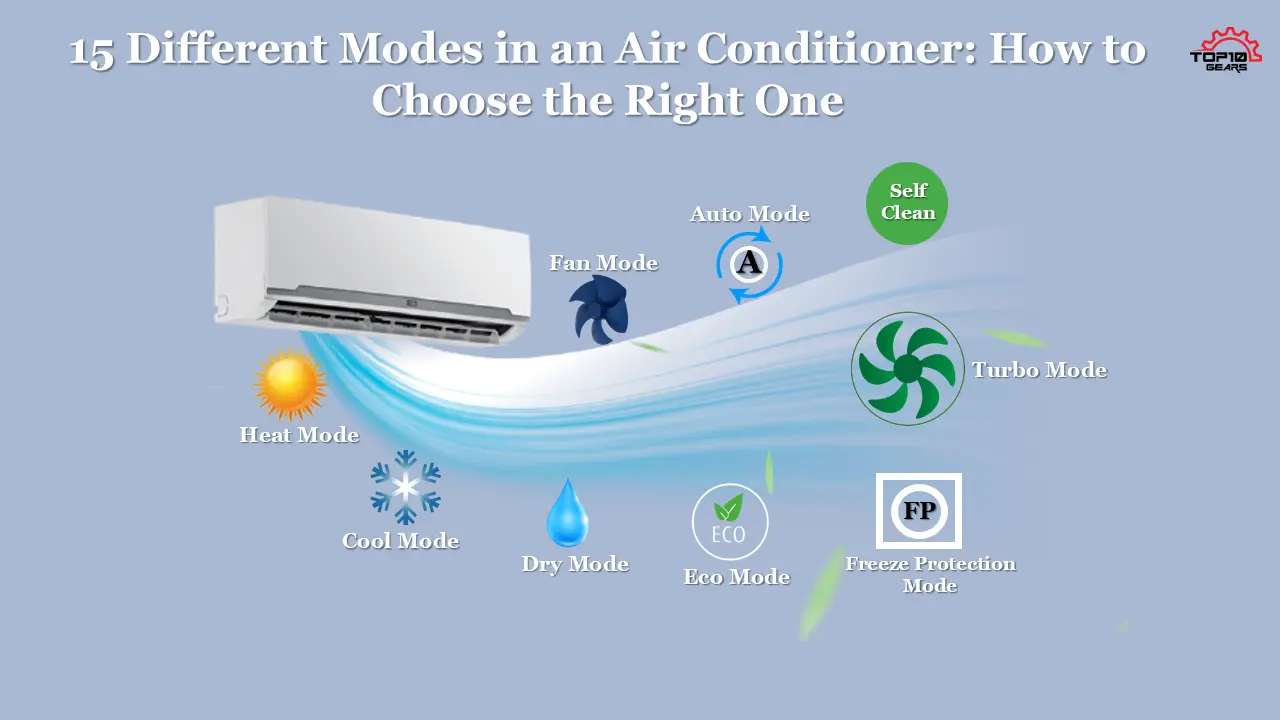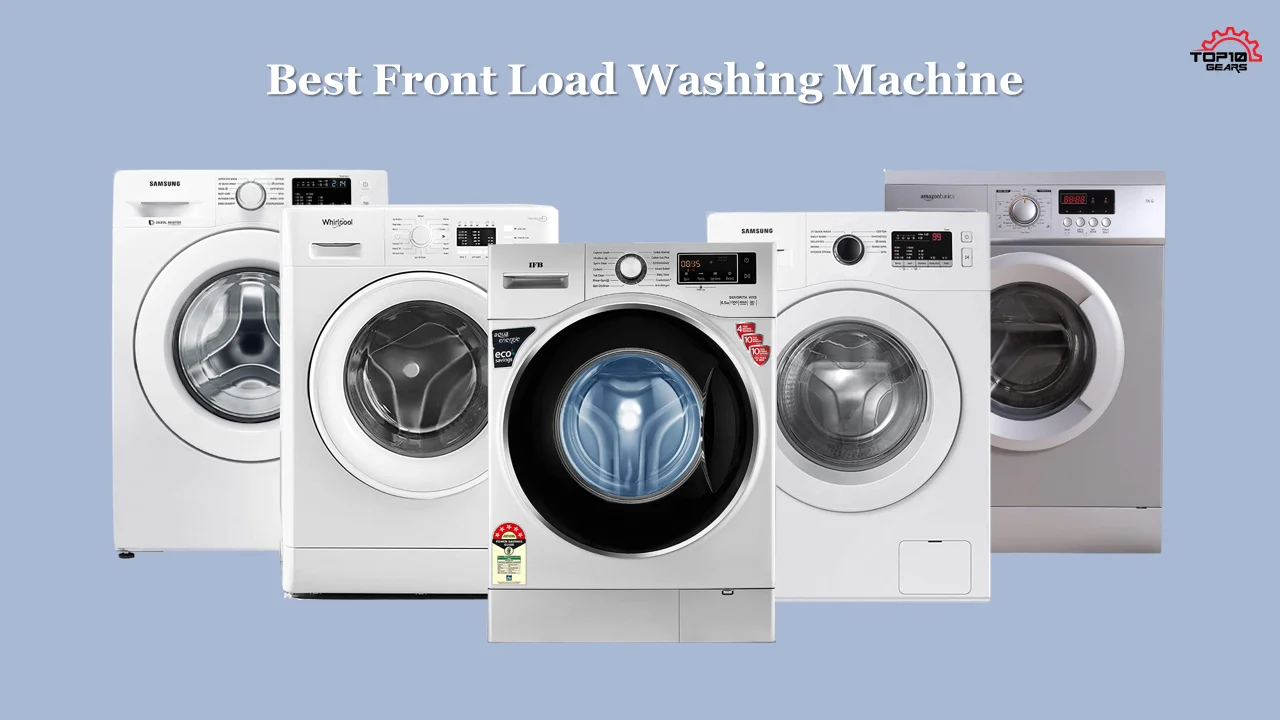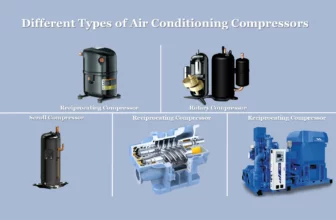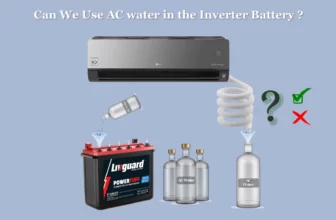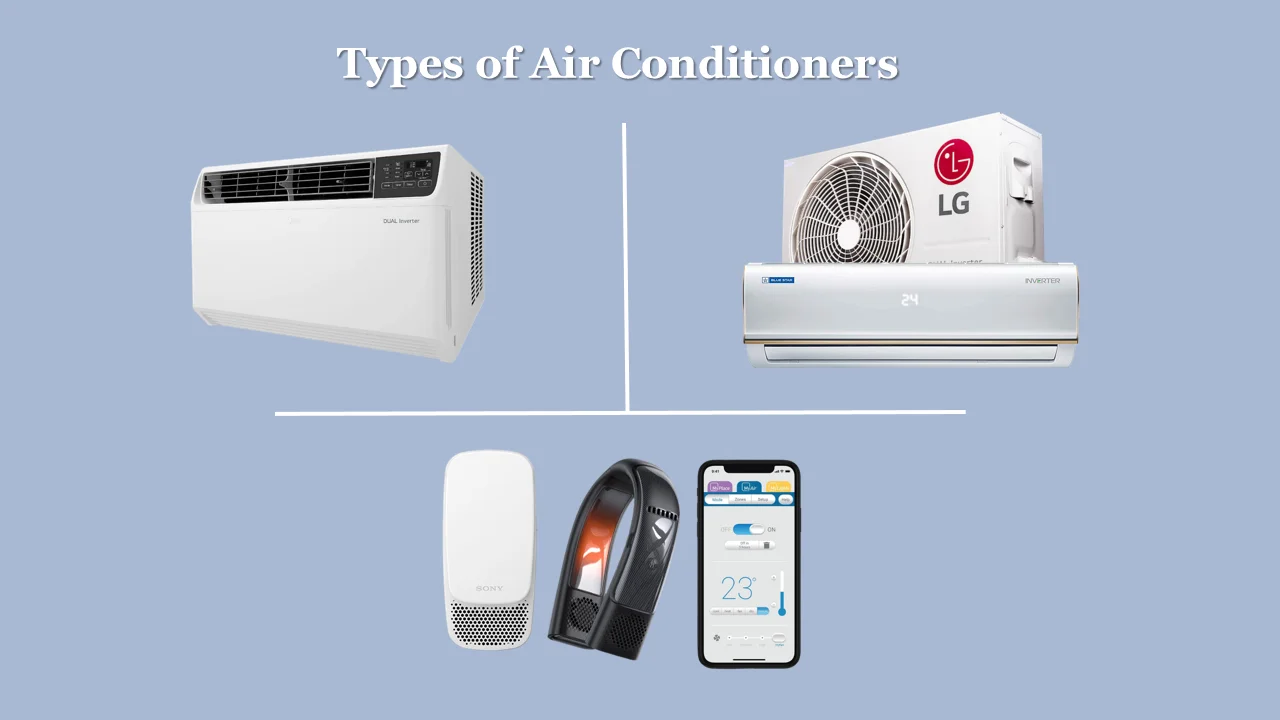
When the weather starts warming, it’s time to think about air conditioners. If you’re in the market for a new AC unit, it can be tough to decide which one is right for you. Like many of us, when we decided to install a brand new AC unit in our house, I was also confused about which one to buy because there are many different types of air conditioners for home use, and each has its benefits and drawbacks.
So, I did a bit of research on the internet, consulted my engineering friends, and took some professional help. They all guided me to go for a multi-split Daikin AC because we have many rooms and spaces, and each family member has different comforting temperatures.
Choosing the types of Air Conditioners was initially confusing and overwhelming, but it all got clear after diving deep. These AC units range from small, standalone window units to large central AC systems that cool an entire house at once. Which one is best for you depends on your specific needs and budget.
After going through the process of choosing the best type of AC for our home, I have decided to share my findings in the form of this article.
In this post, we’ll take a closer look at the 22 different types of air conditioners with their pros and cons that will help you decide which is best for your needs. I have also given a few factors that you need to consider while choosing the best AC for your home. These all Air Conditioners are residential ACs i.e. for use at homes and apartments.
Before wasting your time, let’s dive deep and Stay Cool!
- Stand Alone AC System
- Split AC System
- 10. Central Air Conditioner
- 11. Split Air Conditioner (Ductless Mini-Split)
- 12. Ducted Mini-Split Air Conditioner
- 13. Cassette Air Conditioner
- 14. Multi-Split Air Conditioner
- 15. Geothermal Air Conditioner
- 16. Wall Mounted Split Air Conditioner
- 17. Floor Mounted Split Air Conditioner
- 18. Air Source Heat Pumps
- 19. Hybrid/Dual Fuel Air Conditioner
- Other Different Types of Air Conditioners
- How to Choose the Best Type of Air Conditioner for Your Home?
- Frequently Asked Questions
- Final Verdict
All types of air conditioners are divided into two broader categories.
Based on the number of units, there are two types of air conditioning systems.
- Stand-Alone System
- Split System
Stand Alone AC System
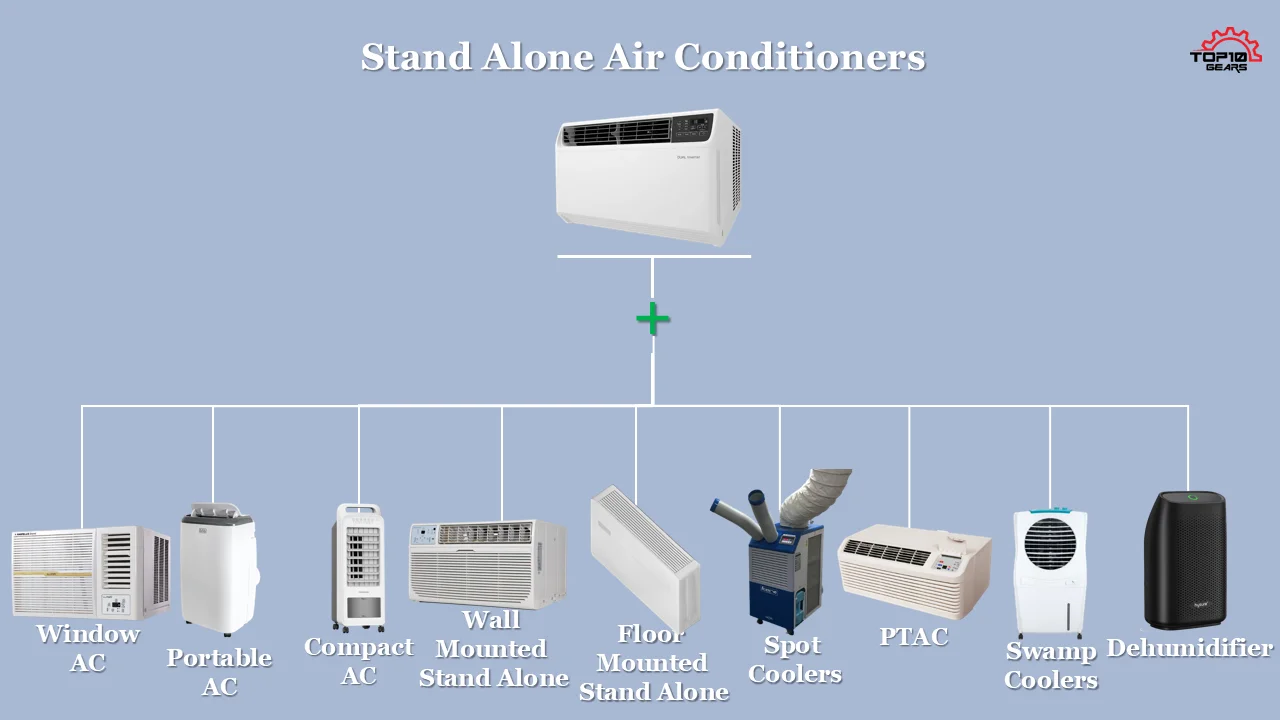
These are the most basic type of air conditioners. The stand-alone system has only one unit. This unit can be either installed inside or outside the house and cools the air before sending it inside. If you choose to install it outside, you will need to purchase a separate condensing unit.
The main advantage of this monoblock type of air conditioner system is that it is very easy to install since there is only one unit. They are generally less expensive than other types of air conditioners, but they also have some drawbacks.
First, standalone systems are not very energy efficient, so they can be expensive to operate. Second, they can be quite loud when operating since all the components are located in one place. Due to this, it may not be ideal if you live in a small space or have close neighbors.
Finally, they require regular maintenance in order to keep them running properly, which can be a hassle.
Now, let’s see the examples of these systems one by one. First, we will discuss stand-alone systems.
- Window Air Conditioner
- Portable Air Conditioner
- Compact Air Conditioner
- Wall-Mounted Air Conditioner or Through-the-Wall Air Conditioner
- Floor Mounted Stand-Alone Air Conditioner
- Spot Coolers
- Packaged Terminal Air Conditioner
- Evaporative Coolers or Swamp Coolers
- Dehumidifiers
1. Window Air Conditioner
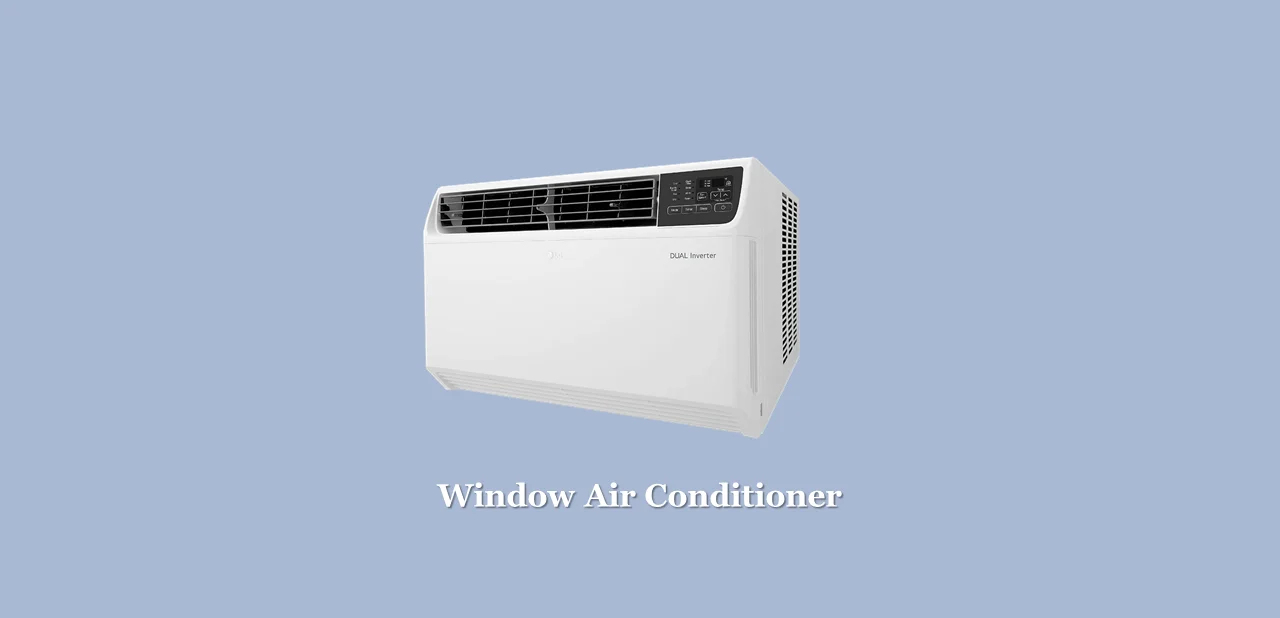
Window ACs are one of the most basic and popular types of stand-alone air conditioners with all its components enclosed inside. These single units are small and self-contained ACs that fit in a window frame outside your home and use room air to cool the space inside.
These AC units come in different sizes and are suitable for cooling a single room or a small area. They’re relatively inexpensive than other types of ACs and are easy to install yourself.
Window air conditioners can only cool the room in which they are installed. This makes them ideal for small rooms and is labeled as champions of cooling smaller spaces. They’re best suited for smaller spaces like apartments or single-family homes.
Window Air conditioners are champions of cooling smaller spaces.
However, window air conditioners must be mounted in a window and can take up a lot of space in your home. Not only that, these affordable air conditioners have some other drawbacks as well.
First, window units are not very energy efficient (have lower energy efficiency ratings), so they can be expensive to operate. Second, they can be pretty loud when operating, which may not be ideal if you live in a small space or have close neighbors.
Finally, they require regular maintenance to keep them running correctly, which can be a hassle.
2. Portable Air Conditioner
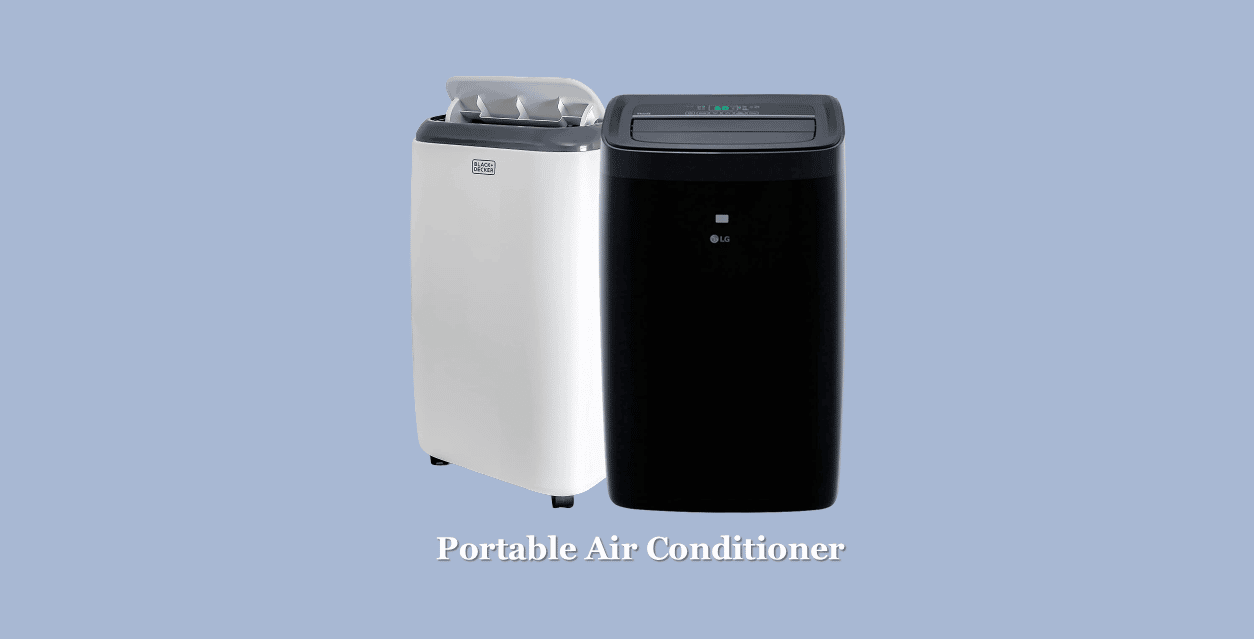
Portable air conditioners are self-contained single-unit systems with all their essential air conditioning components enclosed inside a single frame. It makes these units ideal for indoor use where you want temporary space cooling, or the rules and building regulations or any other restriction don’t allow the installation of different types of air conditioning units.
These AC units sit on the floor and vent cooled air into the room through a hose that exhausts outside. They’re also relatively affordable and do not require any complex installation.
Portable ACs are versatile and free-standing units and can be moved from room to room as needed. They generally have caster wheels and are easy to roll from one place to another. So, they’re a good option if you need cooling in more than one room or space. Portable ACs are perfect for small spaces like bedrooms, offices, or RVs and boats.
Portable air conditioners are available in various designs, shapes, and cooling capacities. They can be easily wheeled from one place to another as per the requirement.
They’re also lightweight and easy to transport as easily as a vacuum cleaner, so they’re perfect for people who move frequently or don’t have a lot of storage space.
Based on the cooling method, portable ACs are of two types
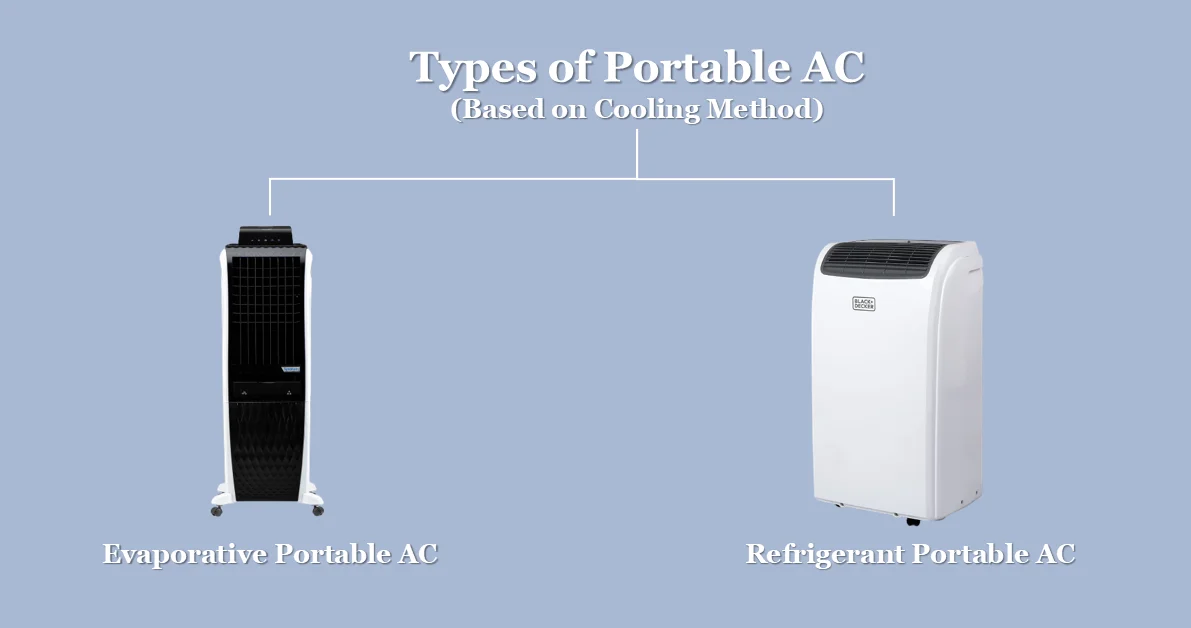
- Evaporative Portable Air Conditioners, and
- Refrigerant Portable Air Conditioners.
Evaporative Portable ACs
Evaporative portable ACs are the most common type of portable air conditioner. They use a fan to blow hot air over a wet pad, which cools and humidifies the air.
These units are less expensive than refrigerant-based portable ACs but are not as effective in humid climates.
Refrigerant-Based Portable ACs
Refrigerant-based portable ACs use the same technology as traditional window air conditioners. They have a compressor that cools and circulates Freon or another type of refrigerant through coils. These units are more expensive than evaporative ACs but more effective in humid climates.
So, if you live in a humid climate, you may consider a refrigerant-based portable AC instead of an evaporative AC.
Based on Design, portable ACs are of two types:
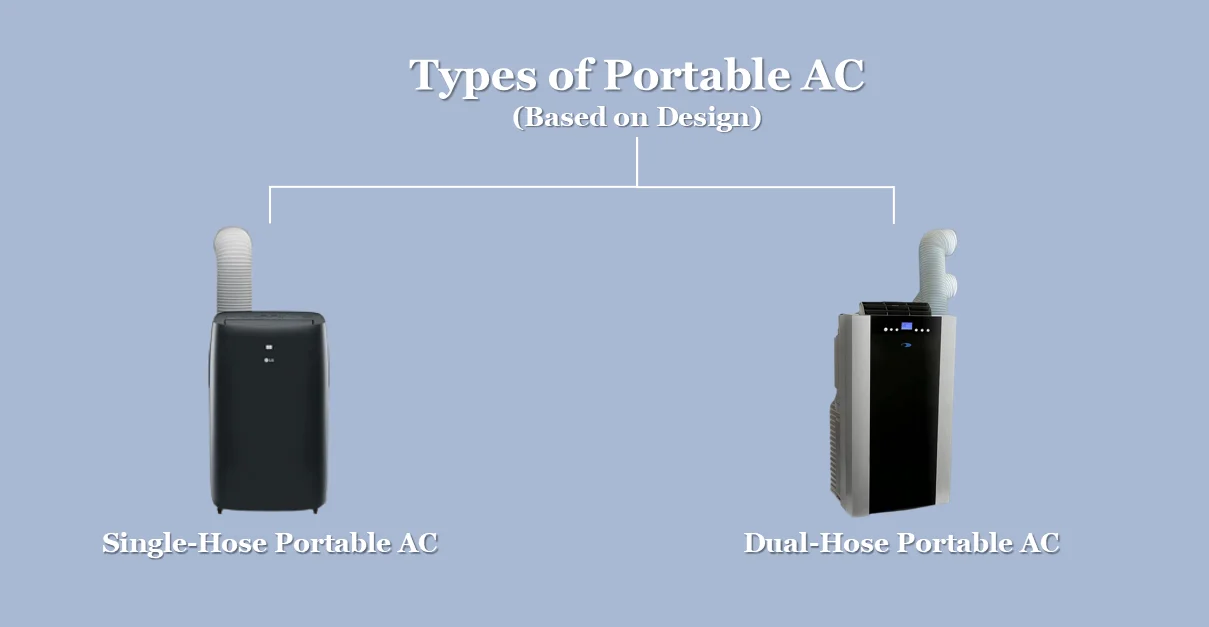
- Single-hose Portable AC
- Dual-hose Portable AC
Single-Hose Portable Air Conditioners
Single-hose Portable ACs are more common and use only one hose for both the intake of air from the outside and the exhaust of hot air to the outside.
Dual-Hose Portable Air Conditioner
Dual-hose Portable ACs have two hoses, one for drawing in outside air and another for venting out hot air. One hose is used to pull in air from the outdoors, which the compressor cools via the condenser coil within the unit. The other hose is used to expel the air outdoors.
They are more expensive than their single-hose counterparts but are also more energy-efficient.
Some portable air conditioners have a remote control feature, making them even more convenient to operate. However, these portable AC units require a power outlet and access to a window to send out the hot air through the exhaust hose.
The other downside to these air conditioners is that they are slightly noisier than other home air conditioners because the condenser and exhaust fan are put into a single casing. They have low energy efficiency ratings and are not very effective at cooling spaces bigger than 500 sq. ft.
3. Compact Air Conditioner
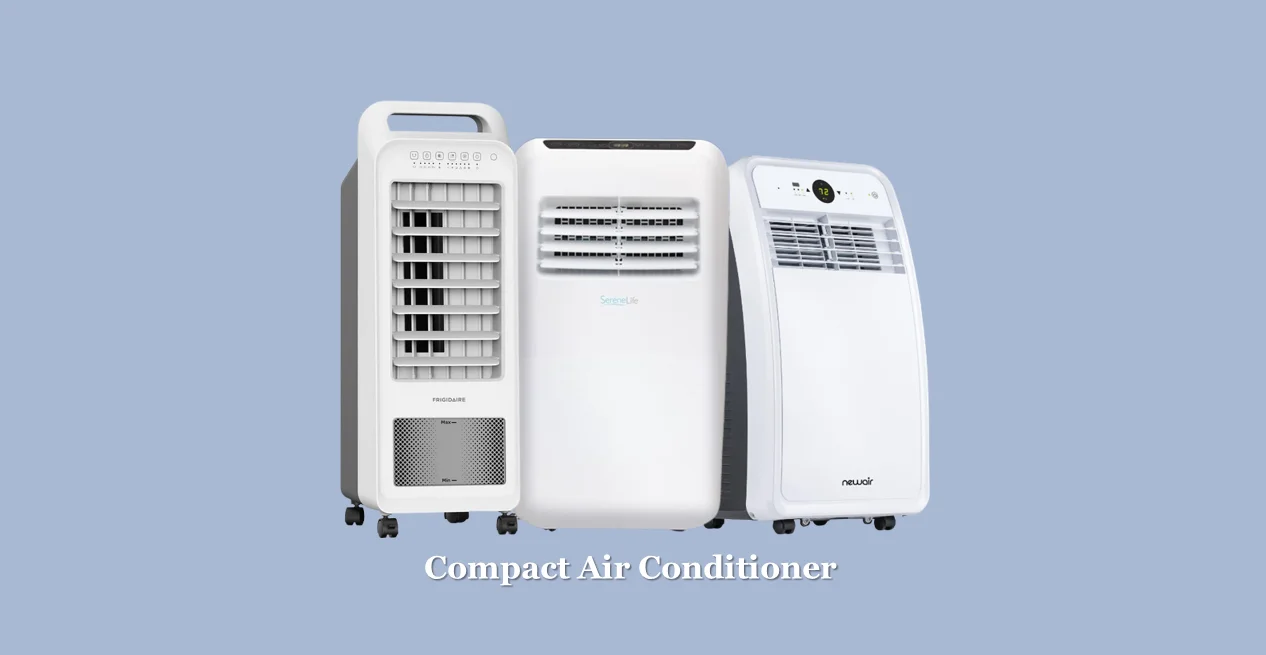
Compact air conditioners are yet another stand-alone type of air conditioner. They are smaller versions of portable ACs meant for small spaces like dorm rooms, apartments, or any other small area that needs to be kept cool.
These units are an excellent option for those who want the cooling power of a portable AC unit without the bulkiness, as these AC units are small and lightweight.
Compact air conditioners are also suitable for those who want to cool a small space without spending a lot of money and are tight on space. They’re less expensive than other types of air conditioners.
They are smaller than other types of air conditioners, so they take up less space. These AC units don’t require installation so they can be easily moved from room to room.
However, they have low energy efficiency ratings and don’t cool as well as their larger counterparts. These AC units are not suitable for cooling large spaces and can be noisy.
But, if you’re looking for an affordable air conditioning solution for a small space, a compact air conditioner may be the right choice for you.
4. Wall-Mounted Air Conditioner or Through-the-Wall Air Conditioner
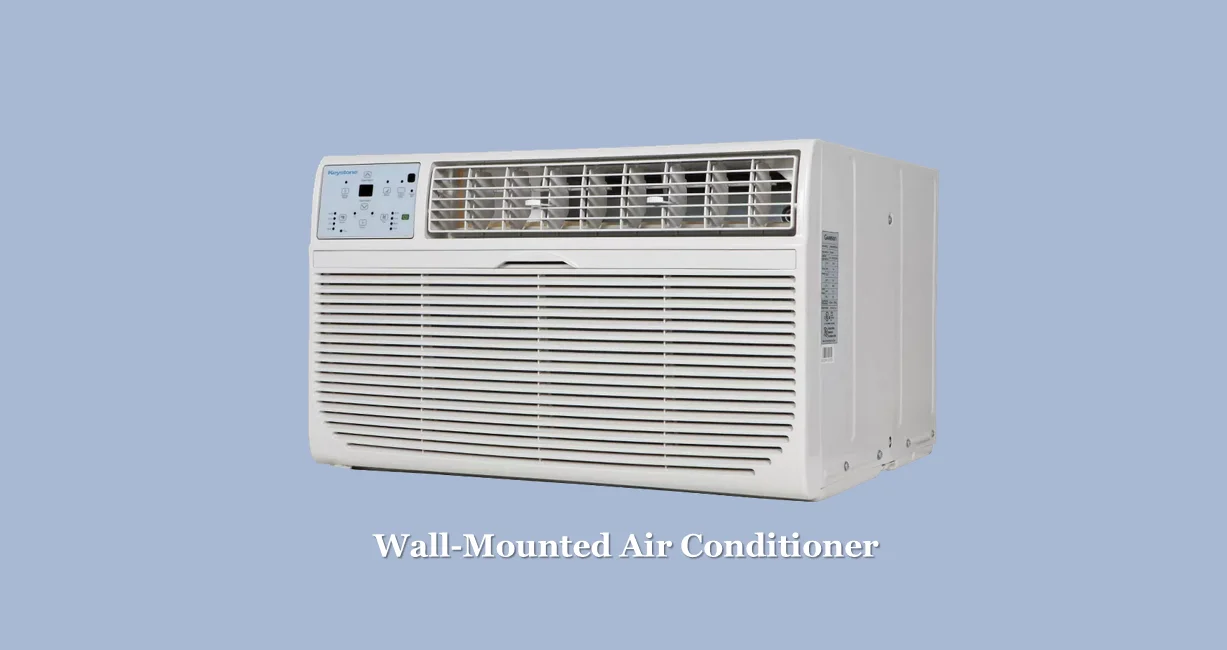
A wall-mounted air conditioner is a type of stand-alone air conditioner that looks similar to a window AC. However, both are different in functionality and use.
A wall-mounted AC is an excellent option if you live in older buildings that become very hot during the summer and want to save space in your home.
In this situation, I personally recommend using a good and powerful split air conditioner. However, you may not be allowed to put any AC shell on the outside wall as these older buildings may be a part of the heritage. So, in this case, you have no choice but to mount the AC unit on the wall.
To install these AC units on the outer wall, you will require an AC support bracket, AC tools, and professional help.
These AC units work by taking the hot air from your room and releasing it outside. For doing this, it is equipped with two pipes, one for taking in hot air and another for releasing cooled air.
Through-the-Wall ACs are different from window AC, although they work in a very similar manner. They both have interior and exterior components connected by copper tubing and electrical wiring.
You can use a window AC as a wall-mounted Air Conditioner, but you can’t use a wall-mounted AC as Window Air Conditioner.
The main advantage of wall-mounted AC over window units is that they are much more secure since no one can remove them from the outside. In addition, wall-mounted air conditioners are less likely to leak than window units.
These types of air conditioners are generally more expensive than window types. It can be controlled with a remote, making them very convenient.
However, they can be pretty noisy, so if you’re looking for a quiet option, this might not be the best choice.
The main disadvantage of wall-mounted air conditioners is that they require professional installation, which can be costly. In addition, they cannot be moved from one room to another, so if you want to use them in multiple rooms, you will need to purchase a separate unit for each room.
5. Floor Mounted Stand Alone Air Conditioner
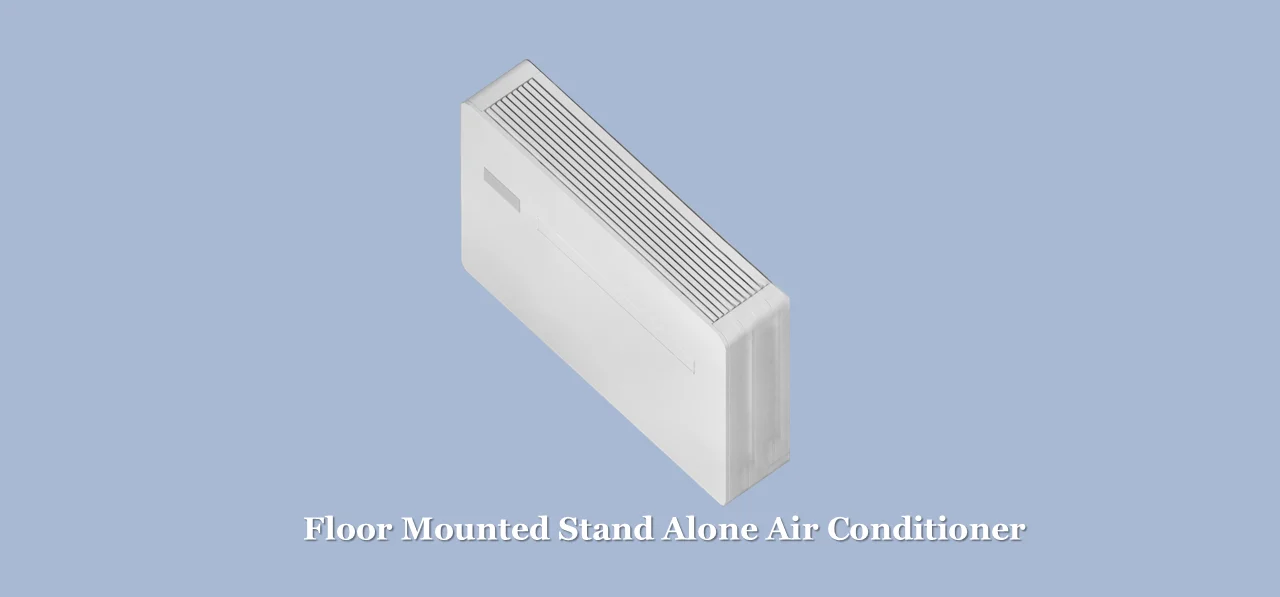
Floor Mounted Stand Alone Air Conditioner is similar to a wall-mounted stand-alone, except that this type of AC is installed on the floor through an exterior wall, usually near a window or door. It provides cooling to a single room or area and does not require a window for installation.
It is an excellent choice if you have limited space, as it can be easily installed in the corner of the room or placed in any room with an exterior wall, including bedrooms, living rooms, kitchens, and offices. It comes in various sizes to cool small or large spaces.
This type of air conditioner is the best for those looking for an air conditioner with a sleek and modern design. It is also perfect for those who do not have windows to mount a window unit and do not want the bulkiness of a wall-mounted unit.
A floor-mounted air conditioner is a large, more powerful monobloc AC unit with all its components enclosed inside a single frame that vents cooled air into the room and does not require any complex installation.
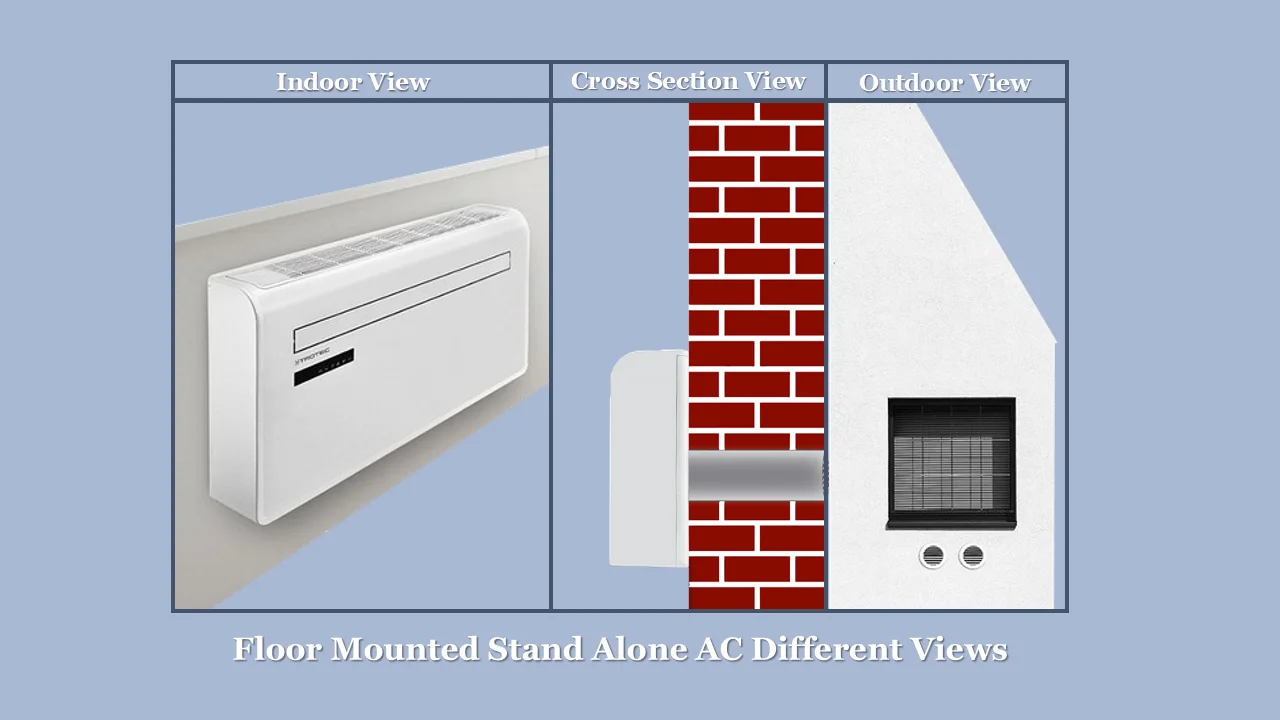
The floor-mounted stand-alone air conditioner has one condensate drain pipe and two metal pipes or small vents going through the wall to release the heated air and water.
It is also great for cooling large rooms or open spaces that get a lot of sun exposure and take up less space than a window unit. They have more BTUs than window units.
These units are usually used in large rooms or office spaces and offer more flexibility in terms of placement. They’re also a good choice if you have multiple rooms that need to be cooled, as you can purchase multiple units and place them in different rooms.
Floor-mounted air conditioners are more energy efficient than window air conditioners, as they don’t lose any cold air to leaks around the unit and have better circulation. They can cool the room more evenly and are less likely to be stolen.
Most floor-mounted units come with a remote control so that you can adjust the temperature from anywhere in the room.
However, floor-mounted ACs can be more expensive than other types and often require professional installation due to their size and weight.
Due to their larger size, they may not fit well in small spaces and can also take up valuable floor space in your home, which may not be suitable for small areas or rooms with limited floor space.
Additionally, these types of air conditioners tend to be louder than other types of AC units. If you have a baby or young children in your home, you may want to consider another type of air conditioner so they can sleep peacefully.
It is also not as popular as other air conditioner types and requires regular maintenance for optimal performance.
6. Spot Coolers
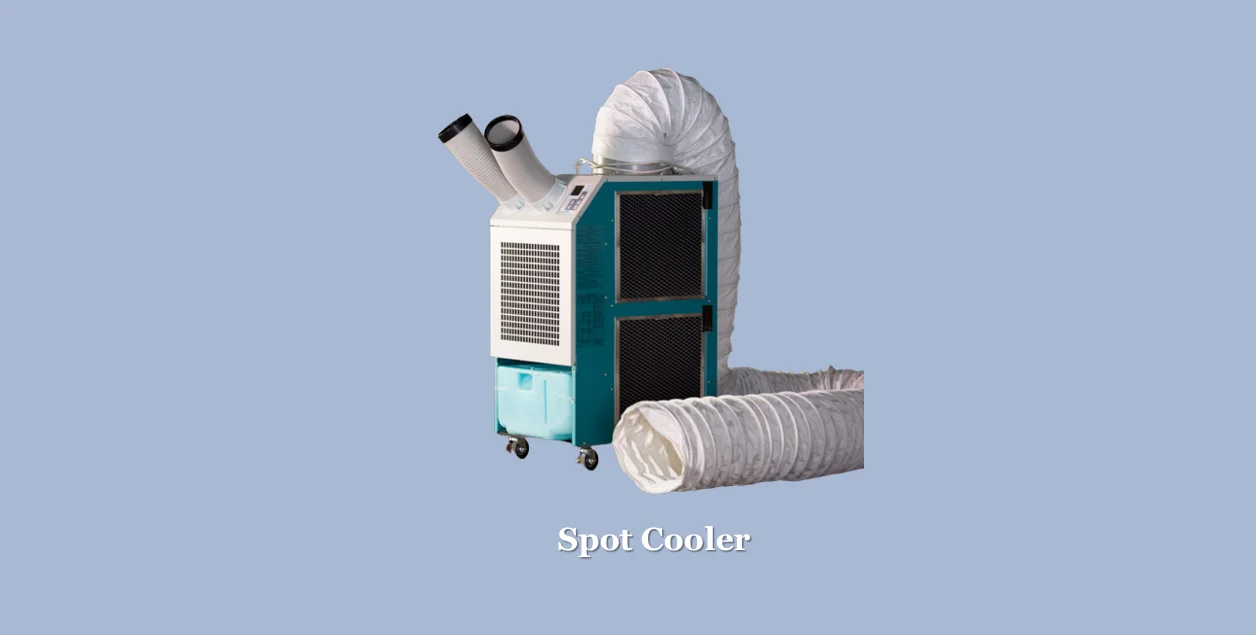
These AC units are self-contained and portable air conditioning systems on wheels that can be placed in a specific spot in a room or where you need them. They’re great for small spaces and can be moved around as needed.
They’re ideal for cooling small spaces, especially computer server rooms, and they’re relatively inexpensive. These units are very powerful and have a cooling capacity of more than 30000 BTU, which can cool a room of nearly 500 sq. ft. They are excellent for providing a cooling solution to boats, ships, or even an airplane.
Spot coolers have two or more pipes that circulate the air. One of these pipes is called the suction line, while the other is called the discharge line. The spot cooler has a compressor that pumps the refrigerant through a closed-loop coil.
The units work by sucking in air from the room and running it over a closed-loop coil containing refrigerant. The refrigerant absorbs heat from the air inside the room and then cools it down before circulating it back into the room.
This makes the air colder and drier. The cold air is pumped back into the room through another duct or supply. This duct or supply can be adjusted so you can direct the air where it is needed most.
This cooling process produces condensation. The condensation is usually collected in a bucket, turning off the machine when it’s full. You can then empty the bucket and continue using the machine. You can also use the attached hose to drain the condensation into a nearby drain or outdoors.
The main advantage of spot coolers is that they’re portable, so they can be moved from one room to another as needed. They’re also relatively quiet and have a small footprint so they won’t take up much space in your home or office.
The downside of spot coolers is that they only work well in small spaces, so if you have a large area to cool, you’ll need more than one unit. They’re also not as energy-efficient as other air conditioners, so your electricity bills may be higher with spot coolers.
These units are also not very aesthetically pleasing. They don’t work well in humid environments and are expensive to run.
7. Packaged Terminal Air Conditioner
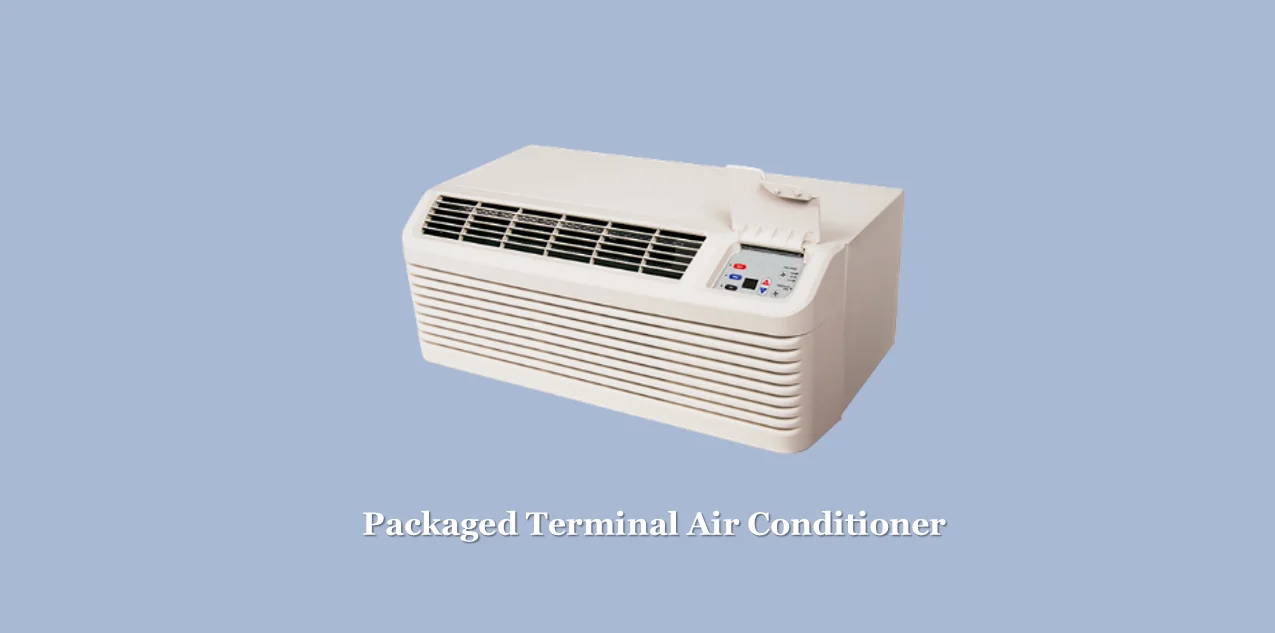
Packaged terminal air conditioners, also known as PTACs or hotel-style air conditioners, are a type of stand-alone air conditioner typically used in hotels, hospitals, apartments, office buildings, senior living facilities, and older buildings.
However, homeowners also use these PTACs units for those spaces of the house that are difficult to cool, like the sunroom, lofts, and attic areas.
These AC units are installed through an exterior wall, and all their components are housed inside one.
These units consist of an evaporator and a condenser. The front part evaporator is located inside the room, and the back part condenser is located outside of the room. Both parts are connected by refrigerant lines.
PTACs also known as Hotel-style Air Conditioners.
Packaged Terminal Air Conditioners are generally commercial-grade air conditioners providing both heating and cooling capabilities for the space they’re installed in, making them a versatile option. It is a popular choice for many businesses because it is easy to install and does not require ductwork.
These types of AC units are great for older buildings that may not have central air conditioning already installed or for larger spaces like hotel rooms where multiple guests need separate temperature control.
These AC units are similar to a window or wall-mounted stand-alone air conditioner, but unlike them, they can be pretty large and bulky, taking up a lot of space on your wall or outside your building. These units are built with durability in mind and can usually handle heavy use.
PTAC units offer individual temperature control by a thermostat, which allows you to set the desired temperature for each room where it is installed. This means you can cool only the rooms you’re actually using rather than wasting energy on cooling unused spaces in your home. The unit will then turn on or off as needed to maintain this temperature.
When choosing a PTAC unit, you will need to decide how many units you need for your building. Each unit can cool one room or area of your building. If you have a large building, you may need multiple units.
They’re less expensive compared to central air conditioning systems but are considered old-tech. They also have lower SEER ratings compared to modern-day mini split systems, so you’ll pay more in running costs over time if you use them frequently throughout your home’s life span.
However, these units are more energy efficient than central air conditioning systems.
The downside to these types of AC units is that they can be quite large and take up valuable space on your walls or windowsills. Compared to the modern-day mini split AC system, these PTAC units can be costly to install, operate and maintain.
They can be quite loud, so if you’re looking for a quiet air conditioner, this may not be the best option.
8. Evaporative Coolers or Swamp Coolers
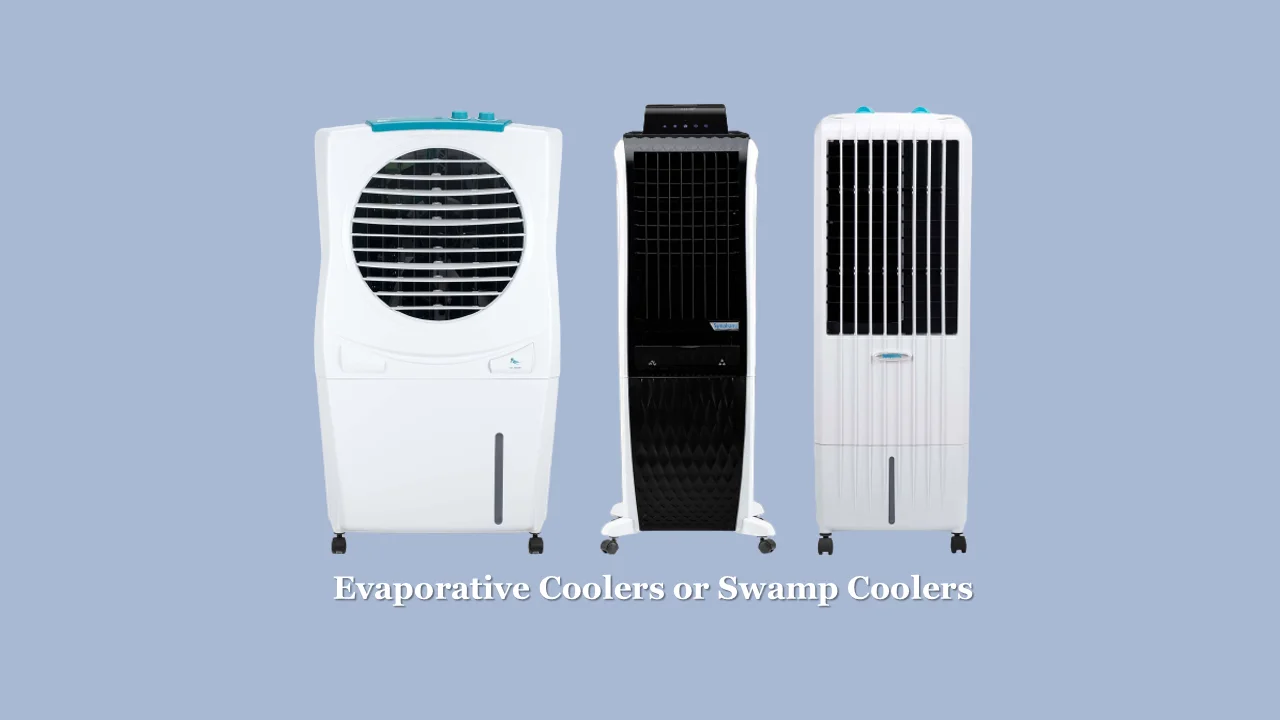
Evaporative coolers, also known as swamp coolers, use the evaporation of water to help cool the air. These air conditioners are often used in dry climates and work best in low humidity.
It relies on the principle of evaporative cooling. In this method, the cooler is filled with water. When started, these units start pulling in hot and dry air from the surrounding.
A fan inside the cooler blows air over the wet pads, which causes evaporation. As the water evaporates, it cools and humidifies the air, which is then circulated throughout the room or space by the fan.
In low-humidity areas, evaporative coolers can be up to 75% more energy-efficient than traditional air conditioners. These AC units are also convenient and portable as they can be moved from room to room and don’t require complex installation.
Evaporative coolers do not use refrigerants, which can harm the environment, and uses less energy than a traditional AC. They are also much cheaper to install than other types of air conditioners. These AC units are also much less expensive to operate and maintain than the traditional ones.
Another good thing about evaporative coolers is that they add moisture to the air, which can be beneficial in dry climates.
However, they are not as effective at cooling as other air conditioners and can add moisture to the air, making the air inside your home more humid.
They also require regular maintenance, such as cleaning the pads and refilling the water tank or a constant water source to operate.
Another downside to these units is that they can be pretty noisy, especially when the pads need to be replaced and cannot be used in enclosed spaces. Evaporative coolers can also be a breeding ground for mold and mildew if not appropriately maintained.
Lastly, these AC units don’t work well in humid climates or enclosed spaces because the evaporation process will not be as effective in high humidity. So, if you live in a dry climate, an evaporative cooler may be a good option for you. But if you live in a humid climate, you should avoid these units.
When operating an evaporative cooler, you must keep the door or window open to allow fresh air to enter. Otherwise, the unit will not work properly and may actually make the room or space more humid.
9. Dehumidifiers
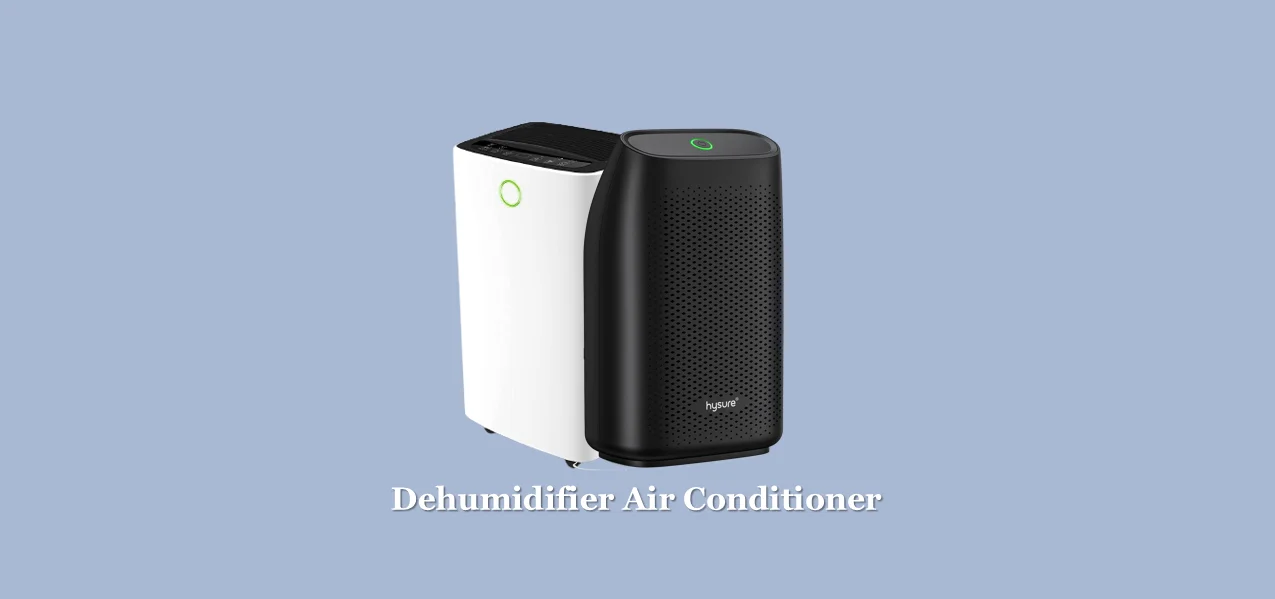
Dehumidifiers are a type of stand-alone air conditioner and come in both portable and whole-house varieties. The portable version looks similar to a portable AC without a big hose. These air conditioners are great for small spaces and can be moved from room to room.
You might want to use a dehumidifier in your home for many reasons. Maybe you live in an area with high humidity or have allergies and need to keep the air dry. Whatever the reason, dehumidifiers can be a great way to improve your indoor air quality.
The primary function of this air conditioning unit is to maintain the air’s humidity level. Dehumidifiers are ideal for homes in humid climates, as they help to remove excess moisture from the indoor air to make it feel cooler when there isn’t any hot weather outside.
These air conditioners can help to prevent mold and mildew growth and make your home more comfortable overall. However, dehumidifier air conditioners can be less effective in very dry climates, as they may actually add moisture to the air.
These Ac units draw in humid air and pass it over a cold coil. It causes the water in the air to condense on the coil, which is then collected and drained away. The air is then passed over a warm coil and released back into the room.
However, like anything else, there are also some potential drawbacks to using a dehumidifier. One of the biggest concerns is that they can add moisture to the air if not used properly. This can cause problems for people with allergies or other respiratory issues.
While dehumidifiers are generally quite effective, they can use a lot of energy. If you have a large area to cool or need to maintain low humidity levels, then a dehumidifier air conditioner may not be the best option for you.
Another thing to consider is that dehumidifiers can be pretty loud. If you have one running in your bedroom while trying to sleep, it can be quite disruptive.
Overall, dehumidifiers can be a great way to improve your indoor air quality. Just make sure you understand the potential drawbacks before you purchase one. Most models of dehumidifiers have Energy Star certification.
Split AC System
Split systems are more popular than stand-alone systems because they offer several advantages over their counterparts. The first type is the split system, which as the name implies, has two units. One unit is installed inside the house known as an indoor unit while the other is placed outside called an outdoor unit. These units are connected by refrigerant lines.
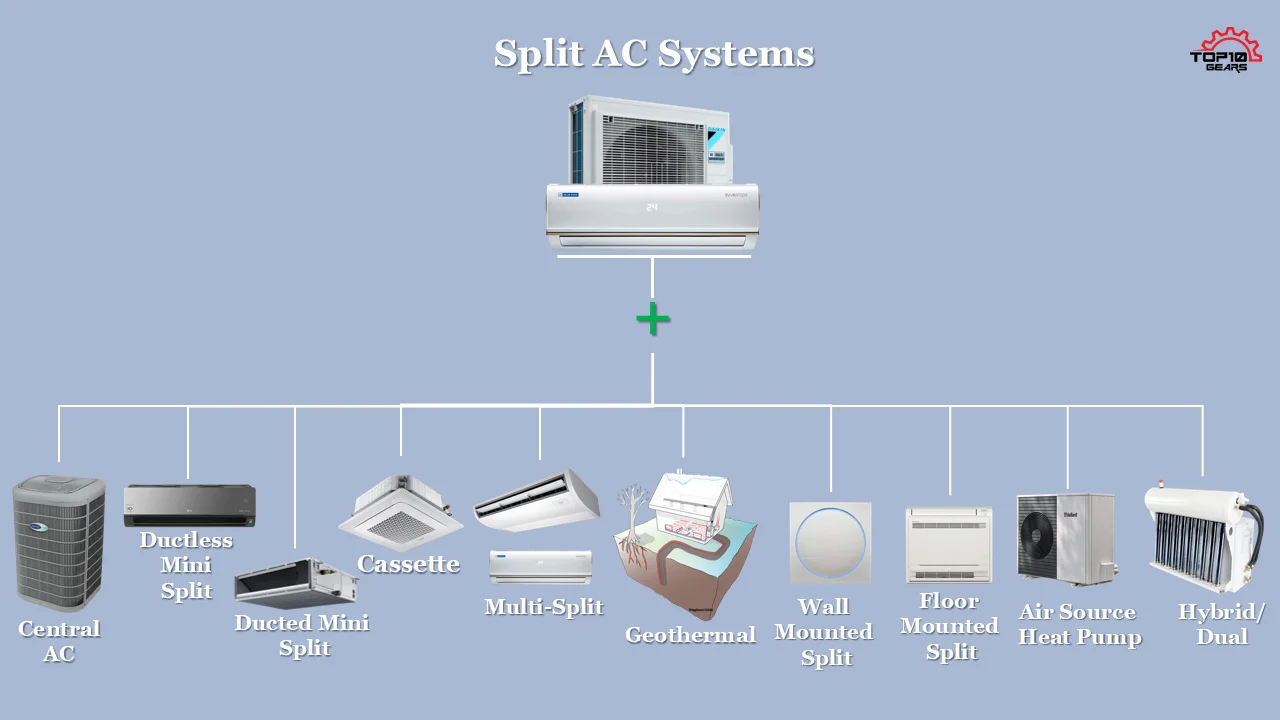
First, split systems are much more energy-efficient, which can save you a lot of money in the long run. Second, they are much quieter than stand-alone systems, so you don’t have to worry about being disturbed by noise.
Another advantage is that you only have to install one outdoor unit, no matter how many indoor units you have. If you want to add more air conditioners to your home in the future, you can simply add more indoor units. Finally, they are much easier to maintain and don’t require as much regular upkeep as stand-alone systems.
However, split systems also have a few drawbacks. First, they are generally more expensive than stand-alone systems. Second, they can be difficult to install, so you may need to hire a professional to do it for you. Finally, they can be less reliable than other types of air conditioners and may break down more often.
Now, let’s see the examples of Split AC systems one by one.
- Central Air Conditioner
- Split Air Conditioner (Ductless Mini-Split)
- Ducted Mini-Split Air Conditioner
- Cassette Air Conditioner
- Multi-Split Air Conditioner
- Geothermal Air Conditioner
- Wall Mounted Split Air Conditioner
- Floor Mounted Split Air Conditioner
- Air Source Heat Pumps
- Hybrid/Dual Fuel Air Conditioner
10. Central Air Conditioner
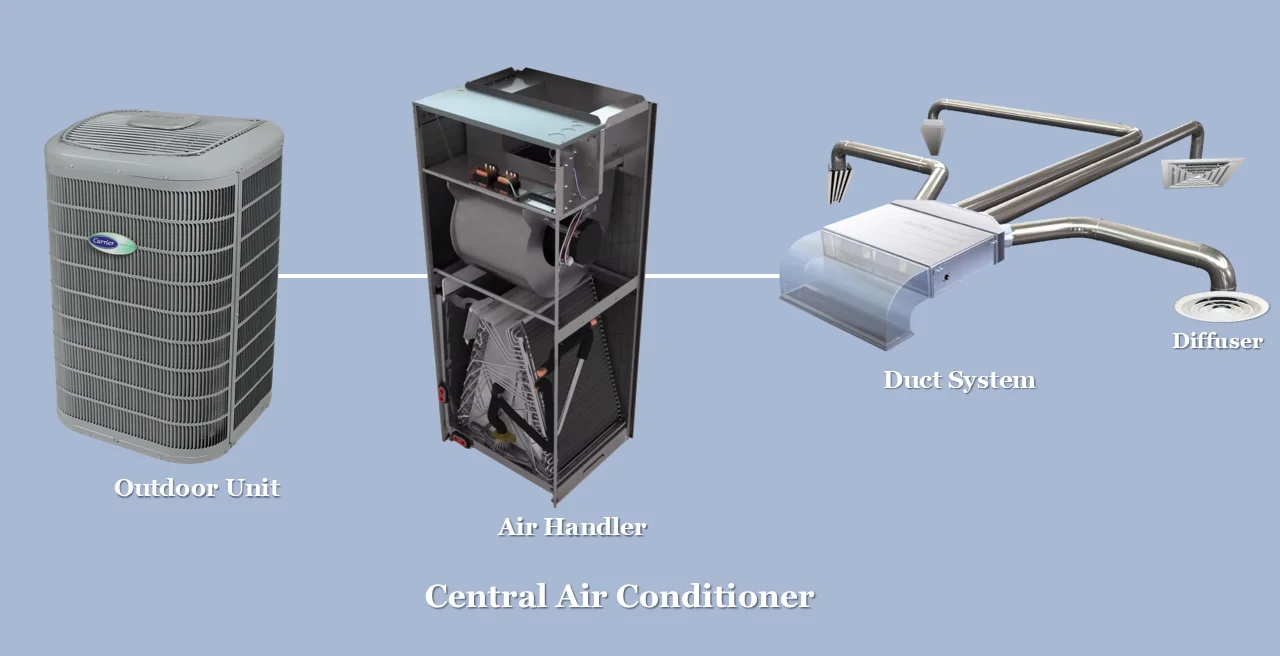
Central air conditioners also known as Ducted Air Conditioners are the largest and most expensive type of AC, but they’re also the most efficient and can cool entire homes at once. In countries like the USA, UK, Canada, etc, it is the most common type of AC unit.
It consists of a large outdoor compressor/condenser, many indoor evaporator coils, and a series of ducts. This type of system works by having a large outdoor compressor unit with refrigerant lines that carry coolant inside the house through an indoor evaporator coil or blower cabinet.
This gives off cold air into each room via vents on its ceiling/walls while drawing heat from outside sources like sunlight coming in through windows as well as absorbing hot exhaust gases from furnaces or gas water heaters.
The cooled air is distributed through ducts to all rooms in the house. A central AC system is best for homes with more than one story, or when the windows are difficult to reach. If you have a large house or live in a hot climate, central AC is likely your best option.
The main benefit of a central air conditioner is that it can cool your entire home at once, making it the perfect choice for large homes. Central AC units are also Energy Star certified and can save you up to 30% on your cooling costs.
However, they require professional installation, so be prepared to spend some money if you decide to go this route.
No matter what type of air conditioning system you choose, make sure to get an Energy Star certification. This means that the unit has been tested and certified by the EPA to meet strict energy efficiency guidelines, so you can be sure it will save you money on your energy bills over time.
11. Split Air Conditioner (Ductless Mini-Split)
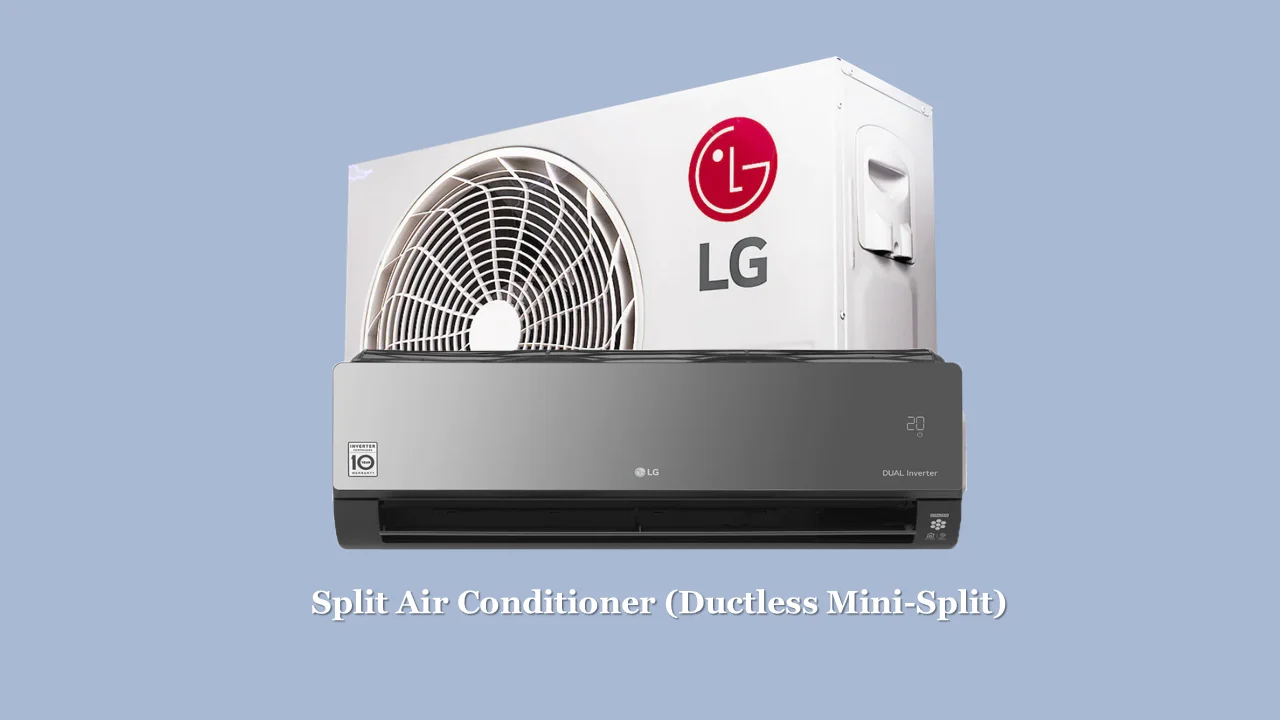
Split Air Conditioners (also known as ductless mini-splits) is one of the most popular types of air conditioner that is becoming increasingly popular as an alternative option to traditional central air conditioning. It is a type of Air conditioner composed of two parts: an indoor unit and an outdoor unit.
The indoor unit is usually mounted on the wall, and the outdoor unit is installed outside the home. Both units are connected by refrigerant lines running through the wall or ceiling cavity between rooms, which allows heat transfer between them.
The indoor unit is housed in the room or space to be cooled and contains a fan, evaporator coil, and compressor. It is responsible for cooling the air. The outdoor unit houses the condenser, provides ventilation, and is usually located outside the room or space.
It doesn’t use ducts to deliver cool air indoors. Instead, each room has its own self-contained AC unit with an outdoor compressor component unit connected directly to an indoor air-handling unit by a refrigerant line.
The outdoor unit of a split air conditioner is usually installed on the ground or on a wall. It is crucial to choose a location for the outdoor unit that is away from any windows so that the noise from the unit does not disturb you.
It offers a versatile cooling solution for our home or business without needing bulky window units or ductwork.
A split system is best for homes with more than one story or when the windows are difficult to reach. It is also suitable for homes with limited space, as they do not require much installation. They are easy to install and can be used to cool or heat a single room.
This type of setup allows for individual temperature control in every space without having multiple indoor blowers blowing cold air throughout your home via one central unit. This feature makes them suitable for cooling specific areas.
Ductless mini-splits are more energy-efficient than other types of ACs because there aren’t any ductwork leaks leaking cool air out before it reaches your living spaces. This makes them an excellent choice for homes without existing ductwork or hot spots due to poor insulation (like attics).
Split systems are quieter than other ACs and offer cleaner air circulation due to built-in filtration systems. These air conditioners can be installed in any room, regardless of size, and provide a high energy efficiency level.
However, they require professional installation and can be more expensive to purchase and maintain than other air conditioners. Additionally, if the indoor and outdoor units are not properly matched, the Air conditioner will not work correctly.
12. Ducted Mini-Split Air Conditioner
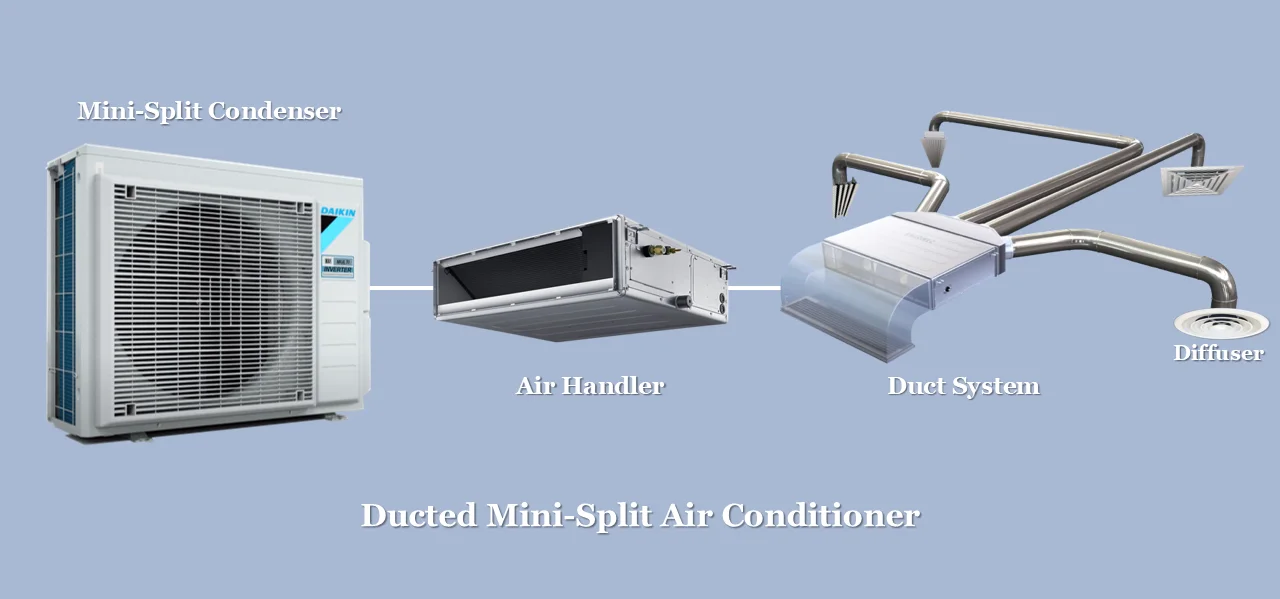
Ducted mini-splits AC, or concealed mini-split, provides the best of both worlds. It has the benefits of inverter technology with the help of a ductless mini-split condenser and the advantage of zone-controlled air conditioning through a zoned air handler of a ducted air conditioning system.
This type of AC system is similar to central air conditioners and mini-split AC units. It consists of a ductless mini-split condenser connected to an air handler attached to small or short ductwork installed in the ceilings or walls of your home. These ducts are hidden behind the walls or ceiling and deliver conditioned air throughout your home through diffusers.
You can control each room’s temperature with a zone controller’s help. This allows you to set different temperatures for different areas of your home.
Ducted mini-split air conditioners are an excellent option for cooling large spaces. This allows you to cool different areas of your home or office without using multiple air conditioners.
Ducted air conditioners are similar to central air conditioners in that they are installed into the ceiling. However, instead of having a big outdoor unit, ducted mini-split air conditioners have small condensers with inverter technology.
Ducted mini-split ACs are more expensive than other types of AC systems, but they offer many benefits. One advantage is that they are very efficient since all the cooled or heated air is distributed evenly throughout the house. They have a high SEER rating and can save you a lot of money on your energy bills in the long run.
Another advantage is that ducted air conditioners are very quiet, making them a good choice for bedrooms or other areas where you want to create a peaceful environment. These units also have a long lifespan and require little maintenance.
It also provides improved indoor air quality and enhanced home comfort levels. You also won’t have to worry about the outdoor unit as it will be hidden away from view.
The downside to ducted mini-split air conditioners is that they require ductwork, which can be expensive to install. Additionally, if your home doesn’t have existing ductwork, you may need to have it installed by a professional. It can be a costly and time-consuming project.
This type of AC unit is more costly than a single-room air conditioner, but it will save you money in the long run because you won’t need to purchase multiple units to cool your entire home.
Overall, if you’re looking for an air conditioner that can provide whole-house cooling and heating, then a ducted mini-split system would be an excellent option for you. Remember that the upfront cost may be higher than other types of AC units. Also, a ducted mini-split system may be the best option if you’re looking for a versatile and efficient air conditioner.
13. Cassette Air Conditioner
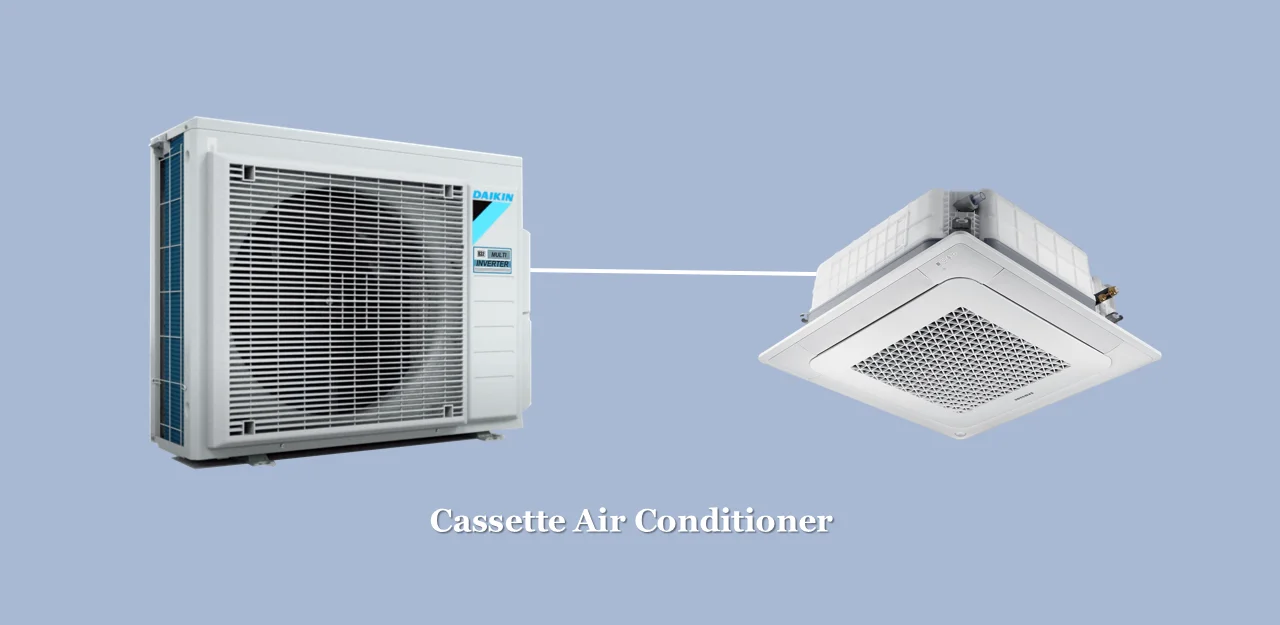
A cassette AC is similar to a wall-mounted ductless mini-split unit with its indoor unit installed in the ceiling above each room. It has a flat panel facing downwards with an external compressor component.
It is not only perfect for small spaces but is also most appropriate for big spaces like offices, restaurants, schools, hospitals, showrooms, etc. It can cool a bigger room faster when compared to the same tonnage wall-mounted split AC due to its high airflow. It is also a good option for anyone looking to save on space.
They are installed in the ceiling and have a sleek, modern design. The slim design takes up very little room, and the discreet installation seamlessly blends in with your décor.
Cassette AC provides better airflow with high coverage area.
The cassette on the ceiling is effectively connected to the outdoor unit via invisible pipes throughout the building, providing a powerful and efficient cooling system.
In this type of AC unit, the direction of cooling air is from top to bottom, providing good airflow throughout a room, which is why it is more effective in large spaces.
This direction of cooling air is also adjustable, so you can choose where you want the airflow to go.
The cassette air conditioners are very efficient with higher energy efficiency ratings and can cool or heat a large space quickly. They can save you money in the long run if you use them frequently throughout your home’s or office’s life span.
Another great feature of this AC unit is that it comes with an automatic restart function, so if there is a power outage, the machine will automatically start back up again when the power returns.
These AC units can be used in both heating and cooling modes. Another advantage is that they are not as noisy as some other types of air conditioners.
However, these ac units are more expensive than other types, such as wall-mounted, portable, or window units. Not only that, these AC units can be challenging to clean and maintain.
Another downside is that they can be difficult to install, so it’s best to leave it to the professionals.
14. Multi-Split Air Conditioner
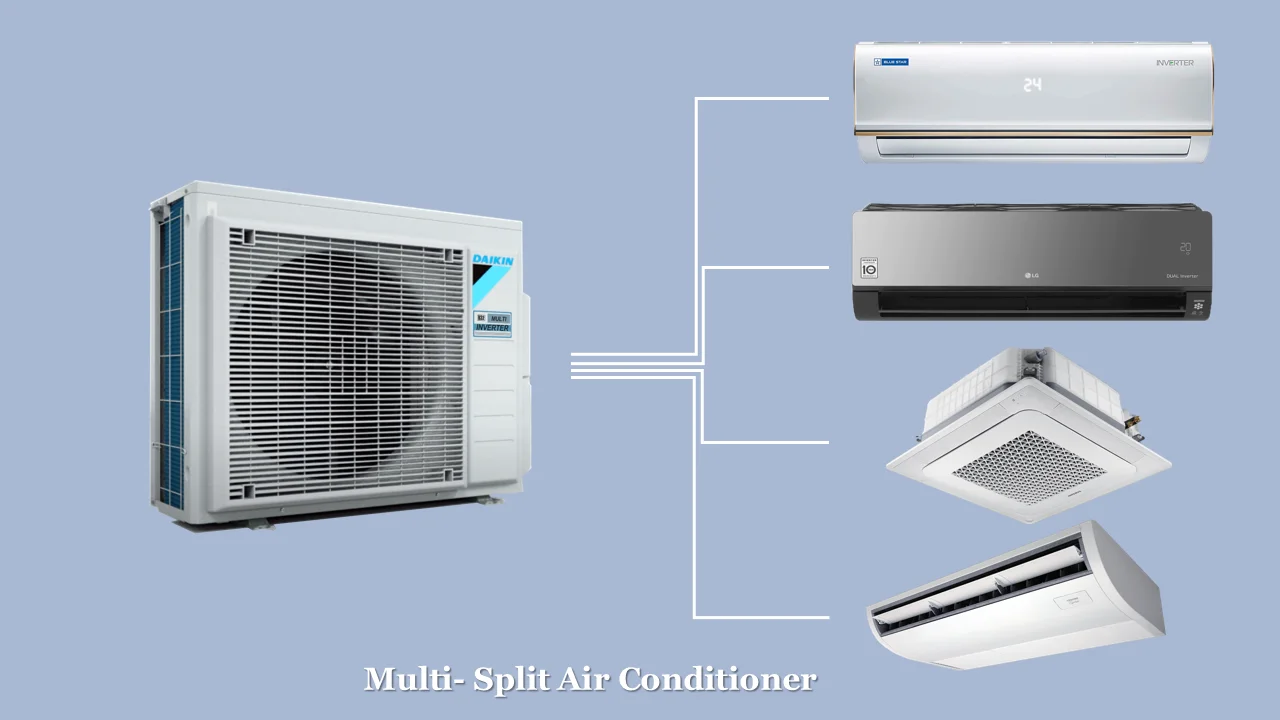
A multi-split air conditioning system is a type of Split Air conditioning system that consists of multiple indoor units connected to a single outdoor unit through refrigerant piping. It is also known as VRV(Variable Refrigerant Volume) or VRF (Variable Refrigerant Flow) System.
Daikin first developed it for commercial buildings. However, nowadays, it is widely used in residential spaces as well.
In this system, the outdoor unit is powerful enough to supply refrigerant to multiple indoor units. The number of indoor units can be as high as 16, but it is usually between two and eight. The indoor unit is similar to a split air conditioner but smaller in size.
Multi-Split Air Conditioning System also known as VRV(Variable Refrigerant Volume) or VRF (Variable Refrigerant Flow) System.
These units are very flexible as indoor units can be turned on or off independently from each other, so you can only cool the rooms that are being used. It is highly scalable, as you can add an extra indoor unit to the system in the future if your needs change.
It looks similar to a central air conditioning system but differs from it as it does not require ductwork, vents, or fans to distribute cool air. Also, it is more energy efficient than having multiple single split air conditioner systems because the compressor only needs to run when there is a demand for cooling from at least one indoor unit.
Multi-split AC system is a good choice for homes where one can’t install multiple outdoor units. It is also suitable for homes with hot and cold spots, as each indoor unit can be set to a different temperature.
When choosing a multi-split air conditioner, you will need to decide how many indoor units you need for your home. Each indoor unit can cool one room or area of your home. If you have a large home or office, you may need multiple indoor units.
It is also getting popular for large homes or offices, as it can provide cooling and ventilation for multiple rooms.
15. Geothermal Air Conditioner
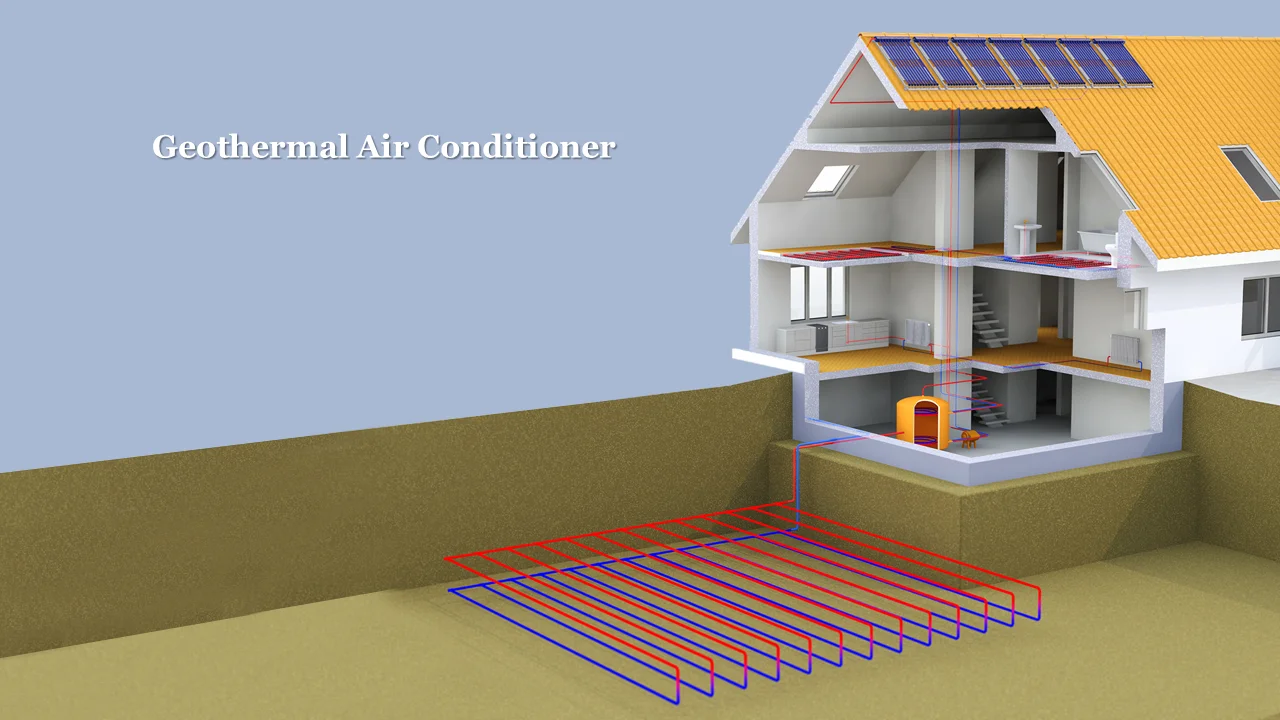
A geothermal air conditioner is an HVAC system that uses the earth’s natural heat to warm your home in the winter and cool it down during warmer months. It is a relatively new method and works by utilizing the insulating properties of the earth.
This type of unit takes advantage of underground temperatures, which stay constant year-round. As the temperatures beneath 4 to 10 feet of ground remain constant year-round, a geothermal AC unit transfers heat from your home to the ground in the summer and does the reverse in the winter.
These AC systems consist of a heat pump(compressor inside) and a series of underground pipes buried in the ground. This piping system consists of a loop that circulates water between your home, a heat pump & the ground. This system also has indoor units with an evaporator coil.
Geothermal air conditioners work by pumping coolant (generally water) through these underground pipes. The heat pump, with the help of coolant, transfers heat from your home into the ground to cool it down in the summer.
In the winter, the process is reversed, and the geothermal AC unit pulls heat from the ground and transfers it to your home.
The working of a geothermal AC system is the same as the working of a traditional AC unit. The only difference is that instead of a compressor coil, an underground piping loop is used for heat exchange.
The main benefit of using this technology is energy savings because you won’t have any heating or cooling costs since there isn’t much fluctuation between indoor and outdoor temperatures throughout the day or night.
These types of AC units are very energy efficient and can save you money on your energy bills. It can reduce your electricity use by 25 to 50 percent!
Geothermal units are very environmentally friendly as they don’t require fossil fuels like oil, gas, coal, etcetera for operation, so they’re good if you want something green too!
They’re also very reliable and have a long lifespan. However, these AC units are expensive to install and require a lot of space on your property. These types of AC units require a professional installation and can take several days to complete.
Overall it is a safe and sustainable alternative to a conventional AC system without any adverse health impacts, but it may not be suitable for everyone.
16. Wall Mounted Split Air Conditioner
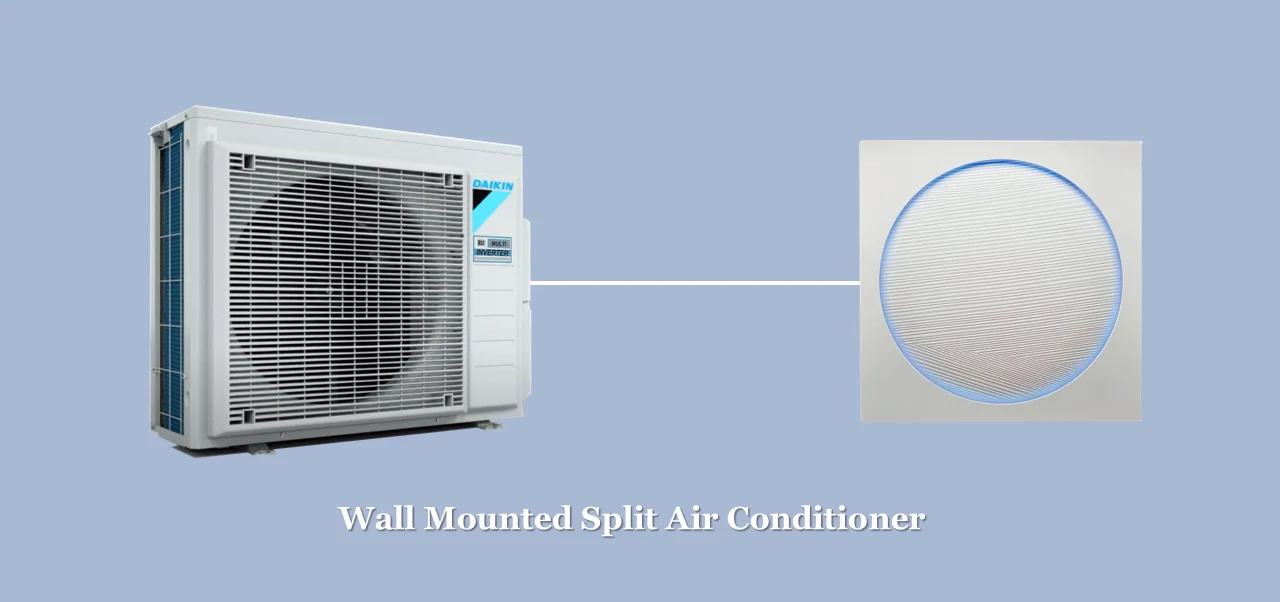
A wall-mounted split air conditioner is a type of HVAC unit that is designed to be installed directly on the walls of a room or space. These are great options if one is looking for something that’s both powerful and compact.
These units are easy to install without too much space in your home and are ideal for smaller areas, such as bedrooms and living rooms. They can be controlled with a remote, making them very convenient.
Similar to other split systems, it also consists of two parts: an evaporator and a condenser. The evaporator is located inside the room, and the condenser is located outside of the room. Refrigerant lines connect both parts.
This type of air conditioner is excellent for older buildings that may not have central air conditioning already installed or for larger spaces like hotel rooms where multiple guests need separate temperature control.
Wall-mounted ACs offer several key benefits compared to other air conditioning systems. They are highly efficient, requiring less energy than traditional units to achieve optimal cooling results.
Additionally, they have a smaller footprint, making them ideal for homes with limited space or those that need an unobtrusive cooling solution.
Wall-mounted split AC units offer individual temperature control by a thermostat, which allows you to set the desired temperature for each room where it is installed.
This means you can cool only the rooms you’re using rather than waste energy on cooling unused spaces in your home. The unit will then turn on or off to maintain this temperature.
Another advantage of wall-mounted air conditioners is their versatility – they can be installed in several different types of rooms or spaces, from living areas and bedrooms to dens and home offices.
Each unit can cool one room or area of your building. If you have a large building, you may need multiple units. So, when choosing a wall-mounted split AC system, you will need to decide how many units you need for your building.
However, there are some downsides to using a wall-mounted air conditioner. For one, these AC units tend to be more expensive than other types of air conditioning systems. These air conditioners require ductwork, which can be costly to install.
Additionally, they may not provide the same level of cooling power as larger traditional systems, making them less suitable for certain types of rooms or homes with high heat loads.
Wall-mounted split AC units are much quieter than window air conditioners and are less likely to leak water into your home.
Overall, if you’re looking for an efficient and highly-versatile air conditioning solution that doesn’t take up too much space in your home, a wall-mounted air conditioner may be a perfect choice!
17. Floor Mounted Split Air Conditioner
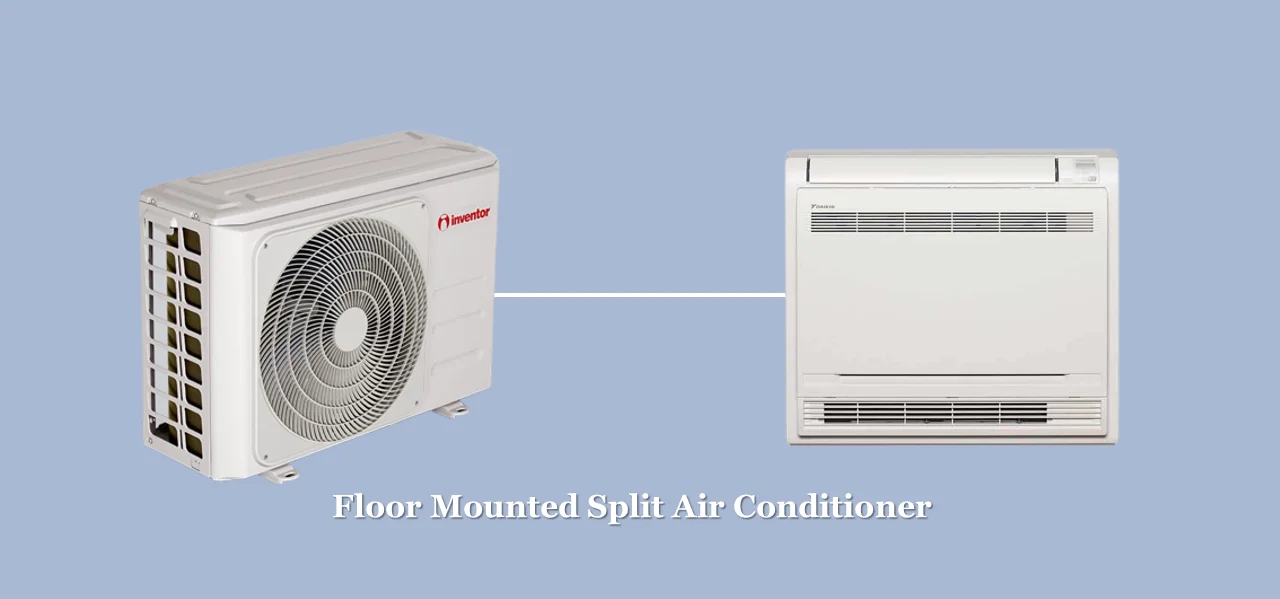
Floor mounted split AC system is similar to a ductless mini-splits or simply mini-splits type of air conditioner that does not require ductwork. The indoor units of these ACs are installed on the floor rather than on the wall. In fact, they’re mounted close to the bottom (up to 6 inches higher than the floor) of the wall.
As the name suggests, these types of AC units are split into two parts: an outdoor condenser and an indoor evaporator. The outdoor condenser is located outside the room or building, and refrigerant lines connect both parts.
These AC units are ideal for spaces with tilted walls, such as attics or buildings constructed using fragile materials like glass or no windows.
Floor-mounted AC units come in different sizes and capacities. Some models are designed for use in small spaces, while others are larger, more powerful, and can cool larger areas.
It takes up less space than wall-mounted units and can be a good option if you have limited wall space. These AC units are also less visible than wall-mounted units, so they can be a good choice if you want to keep your air conditioner out of sight.
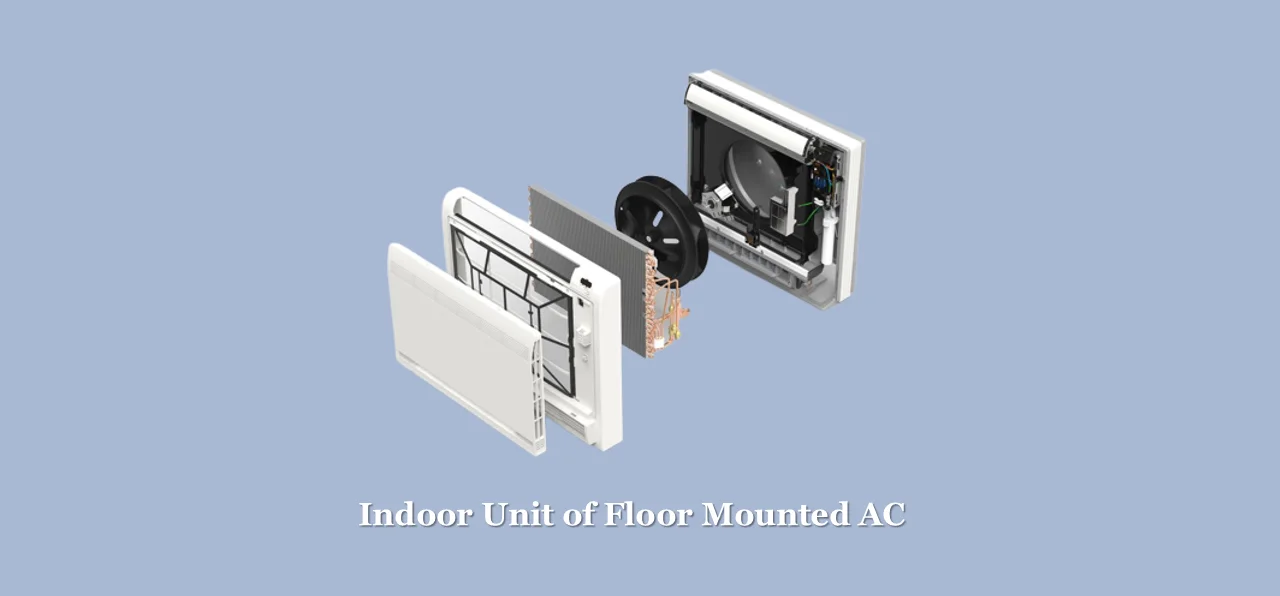
Some think floor-mounted units are more aesthetically pleasing than wall-mounted ones because they’re less intrusive. They can also be easier to install in some cases because you don’t have to worry about finding a spot on the wall that can support the unit’s weight.
Floor-mounted air conditioners are a good choice for rooms with little space, like small bedrooms, bathrooms, or kitchens. They’re also a good choice for offices and other commercial areas.
These AC units’ benefits are that they are less visible and can take up less space. They’re also generally more energy-efficient than window air conditioners and central air conditioners.
These AC units can be up to 40% more energy efficient than central air conditioners because they don’t lose cool air through ductwork like central air conditioning systems.
Another advantage is that they offer individual temperature control for each room or space where they’re installed. This means you can cool only the rooms you’re using, saving you money on your energy bills.
The placement of the indoor AC unit has amazing benefits because it allows you to check the air filters easily. Having easy access to air filters is ideal for people with respiratory issues or who want to keep their indoor air quality as clean as possible.
The main downside to floor-mounted split AC systems is that they can be quite costly to install, especially if you need multiple units for your home. They also require professional installation, so it’s not a do-it-yourself project.
The other downside of floor-mounted AC units is that they may not be as effective at cooling large spaces as different types of AC units.
These floor-mounted air conditioners can take up valuable floor space, which can be a problem in small rooms or if you have a lot of furniture.
When choosing a floor-mounted AC unit, you’ll need to decide how much space you need to cool and what capacity you need. You’ll also want to consider the unit’s noise level, as some models can be pretty loud.
Overall, a floor-mounted unit might be the right choice if you’re looking for an air conditioner that will blend into your décor and not take up a lot of space. Just be aware that they may cost more to install and require professional help.
18. Air Source Heat Pumps
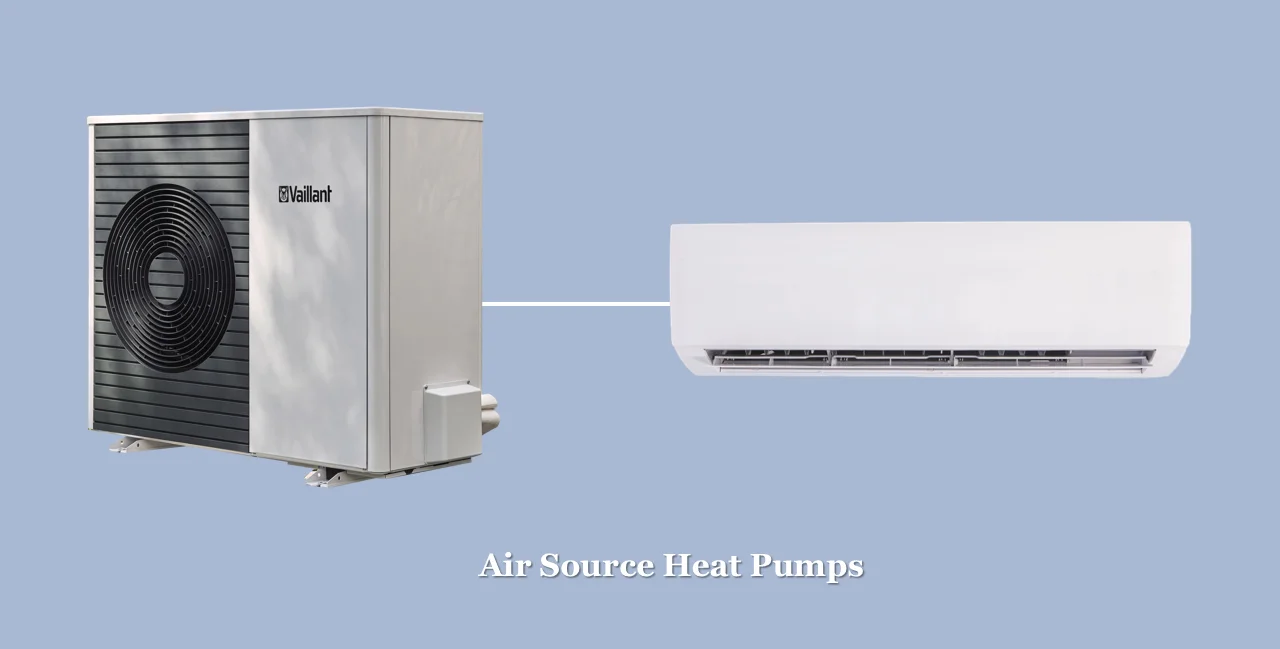
A heat pump is an HVAC or air conditioning system that can both heat and cool your home with the help of ambient air energy. This makes them a cost-effective and environmentally-friendly choice for anyone looking for an AC unit that can handle all types of weather conditions.
An air source heat pump works by transferring warm air into your house or indoor spaces in the winter and removing it in the summer with the help of electricity through the installed ductwork.
They are typically installed on the roof or outside in vents, which take advantage of natural airflow to circulate cool or warm air throughout your home effectively.
It is a low-maintenance cooling solution for homes with ductwork installed and can be a cost-effective option for those who want to reduce their energy bills. These units are an excellent choice for anyone looking for an all-in-one cooling system that can handle any type of weather conditions throughout the year.
Some key features that make air source heat pumps a popular choice include their ability to save you money on energy costs and their highly efficient operation that can help reduce your home’s overall carbon emissions.
They have low running and maintenance costs, making them an excellent choice for anyone looking for an affordable and convenient air conditioner solution.
However, there are some downsides to air-source heat pumps that you should keep in mind when considering this type of AC unit. First, these AC units tend to be more expensive upfront and require regular maintenance to continue working effectively.
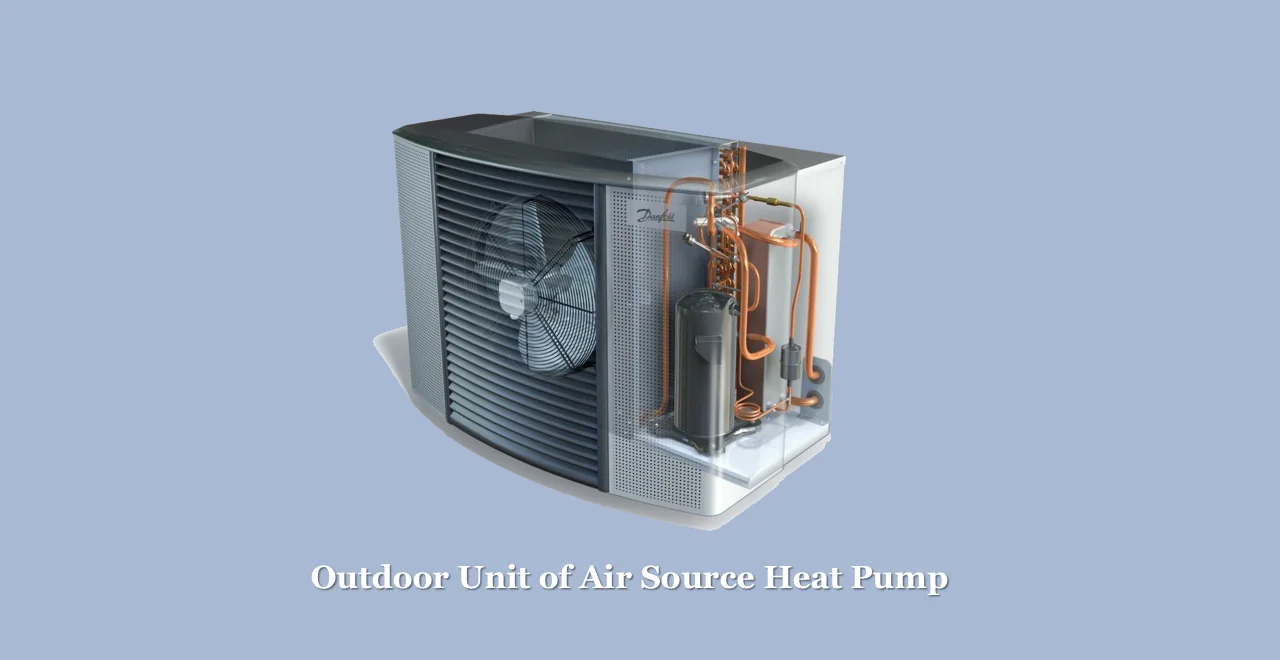
Additionally, since it relies on outdoor temperatures to function correctly, it may not work well during extreme cold or hot weather conditions or where the temperature fluctuates frequently.
Despite these drawbacks, if you’re looking for a reliable air conditioner that is energy efficient and environmentally friendly, an air source heat pump may be just what you need!
Overall, if you live in an area with moderate seasonal temperatures and want a high-quality cooling solution that is also environmentally friendly, an air-source heat pump may be the right choice for your home!
19. Hybrid/Dual Fuel Air Conditioner
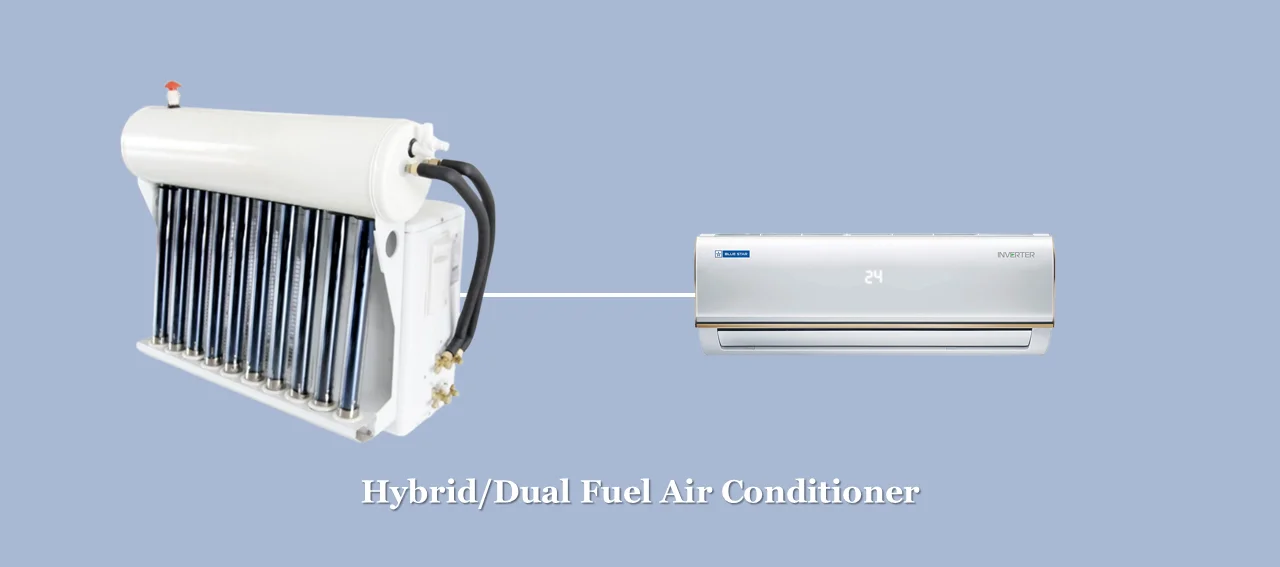
A hybrid or dual-fuel air conditioner is an HVAC unit that uses two different types of energy to operate. The most common type of hybrid AC is a gas furnace (natural gas) with an electric heat pump (electricity). It gives you more control over how much energy you use throughout the year.
This type of AC combines the efficiency and lower cost of a gas furnace with the comfort and convenience of an AC, making it one of the most versatile types on the market.
Depending upon the outer temperature and which option is more cost-effective at that time, either electricity or natural gas will be used to power your AC unit. The system automatically switches between the two types of energy to heat or cool your home.
When it’s cold outside, the gas furnace is used to generate heat. And when it’s warm outside, the electric heat pump is used to cool your home. This means you can save money on energy costs while still enjoying all the benefits of a high-quality AC system.
Hybrid AC units are becoming increasingly popular because they are more energy efficient than traditional AC units. They can also save you money on your energy bills each month. The advantage of using a hybrid AC is that it can provide both heating and cooling, making it ideal for all types of climates.
Other features that make these air conditioners an excellent choice include their ability to monitor indoor and outdoor temperatures in real-time, their ability to intelligently control the AC based on your preferences and schedule, and their advanced air filtration system that can help improve the overall quality of the air in your home.
However, there are some disadvantages to using a hybrid AC as well. First, they can be more expensive to purchase and install than a traditional AC unit. Additionally, they require regular maintenance and service to keep them running correctly.
Finally, if one part of the system breaks down, the entire system may need to be replaced. They may not be available in all areas.
Overall, if you’re looking for a high-quality AC unit that is both energy-efficient and cost-effective, a hybrid or dual-fuel air conditioner may be just what you need!
Other Different Types of Air Conditioners
These types of Air conditioner units may be a stand-alone system or a split system or both or may not fall into any category. These AC units are difficult to classify. Some of these types of Air Conditioners are:
20. Pocket Air Conditioner or Wearable AC
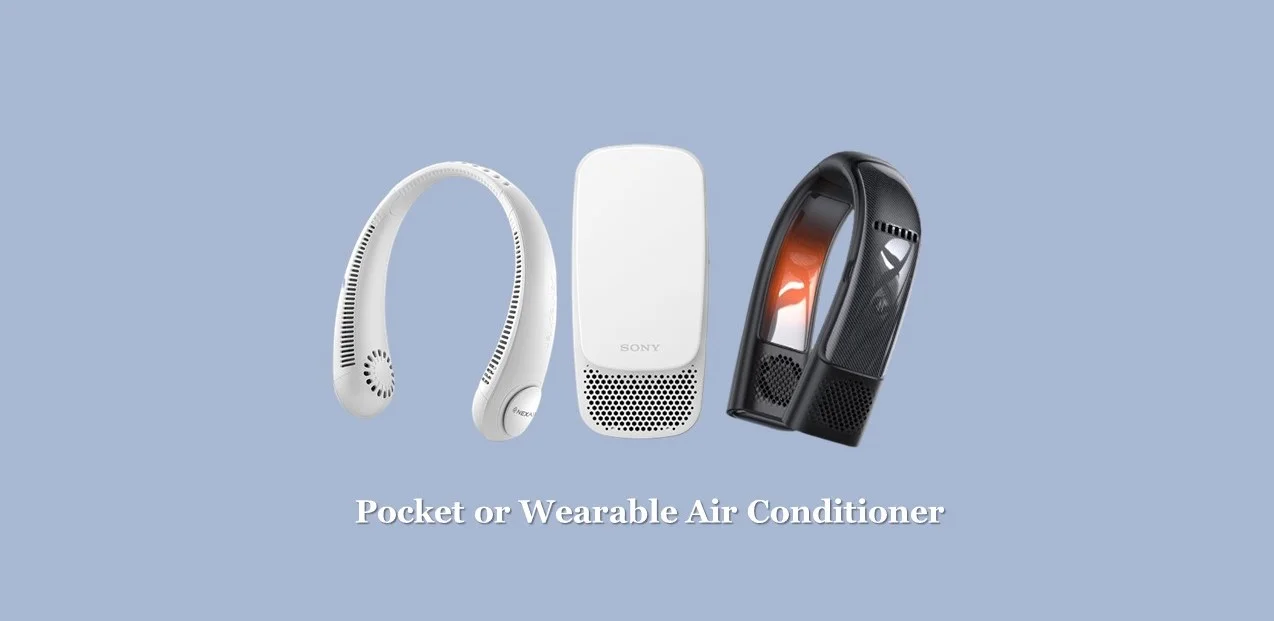
Wearable AC units, also known as personal air conditioners or pocket ACs, are small and portable devices that can be worn on the body to provide a cool blast of air. These types of AC units have become popular in recent years, especially for people who work outside or live in hot climates.
These units are a little bit smaller than an average smartphone and are worn with a specially designed T-shirt or bandana that has a small pocket for the device. The wearable AC unit attaches to the clothing and blows cool air through a small tube.
Some Wearable ACs are worn around the neck like a scarf. Others are banded around the forehead like a headband. A small battery powers the wearable AC, and some models can last up to eight hours on a single charge.
Pocket ACs are becoming increasingly popular because they are convenient and easy to use. They’re also very portable and can be taken with you wherever you go.
These types of Air conditioners are easy to use and require little maintenance. They’re also energy efficient since they only cool one person at a time instead of an entire room or building.
They’re also relatively affordable (some can be pretty expensive for a high-end model) and can be a great way to stay cool in hot weather. But they can also be
However, there are some drawbacks to using a wearable AC unit. These AC units do need to be recharged often and may not provide enough cooling for some individuals in scorching temperatures.
They don’t cool a large area like other types of ACs and require regular maintenance and care to ensure they continue working correctly. They can also be uncomfortable to wear for long periods.
EG: Torras Coolify, Reon Pocket
21. Smart Air Conditioner
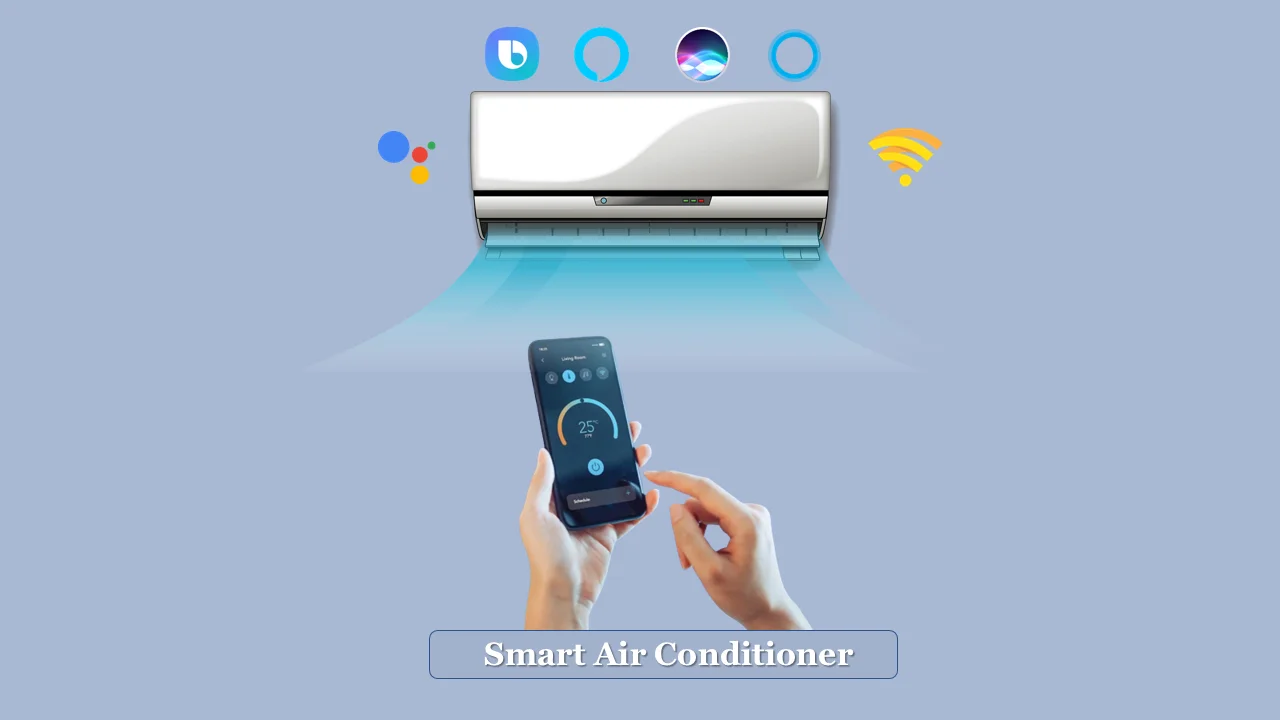
Smart air conditioners are the latest trend in home cooling technology. These air conditioners can be a type of window, portable or mini-split air conditioner that is IoT ( Internet of Things) enabled.
These ACs come with built-in Wi-Fi, can be connected to the internet, and can be controlled remotely from anywhere with a mobile app or voice-activated assistant, such as Amazon’s Alexa.
These air conditioners come with numerous features and a variety of modes, such as cool, fan, dry, heat and eco, etc., that can save you time, money, and energy. These ACs also have sensors that automatically adjust the temperature to your preferences and needs.
Smart air conditioners are more energy efficient than traditional air conditioners. They use less power and operate at a lower temperature, so they cost less to run.
Studies have shown that smart air conditioners can save you up to 30% on your energy bill. It is an excellent option if you want an energy-efficient device that’s easy to use and provides maximum comfort throughout the year, improving your quality of life.
The smart air conditioner comes loaded with tons of features, and the benefits of having such ACs are many.
First, you can control the temperature of your home from anywhere. So, if you’re at work and realize you left the AC on, you can turn it off without running home.
Second, you can set schedules so that the AC turns on before you get home from work or turns off after everyone has left for the day. This can save you money on your energy bill.
Third, a great feature of smart air conditioners is that they can be used in conjunction with other smart devices in your home. For instance, you could set up your AC to turn on when your smart thermostat detects that the temperature in your home is getting too high.
Another benefit of a smart air conditioner is that it is featured with air quality sensors that can help improve your indoor air quality. Traditional air conditioners can circulate dust and other allergens around your home, which can trigger allergies or asthma attacks.
Smart air conditioners are designed to filter out these allergens, so you can breathe easier knowing that your air is clean and healthy.
Some smart ACs come with leak detectors. You can get alerts if the AC isn’t working properly or if the filter needs to be changed. It can help prevent water damage. These features help extend the life of your air conditioner and avoid costly repairs down the road.
A smart air conditioner can also help you sleep better at night. If you suffer from insomnia or other sleep disorders, the cool, comfortable temperature of a smart air conditioner can help you fall asleep and stay asleep.
The lack of noise pollution from a smart air conditioner can also create a more peaceful environment for sleeping.
There are many other benefits of owning a smart air conditioner. But these are just a few of the most popular ones. Overall, smart air conditioners are a great way to save money, reduce your carbon footprint and increase the comfort of your home.
However, the initial cost of purchasing a smart air conditioner is higher than a traditional AC. You need multiple units as these smart air conditioners don’t work centrally.
Not only that, you may need to upgrade your home’s Wi-Fi to accommodate the AC, and not all models are compatible with all smart devices.
Even then, these smart air conditioners are future-proof and a wise investment for any homeowner. So if you’re in the market for a new AC, I personally recommend you to check out the latest generation of smart ACs – you won’t be disappointed!
22. Battery-Powered Air Conditioner
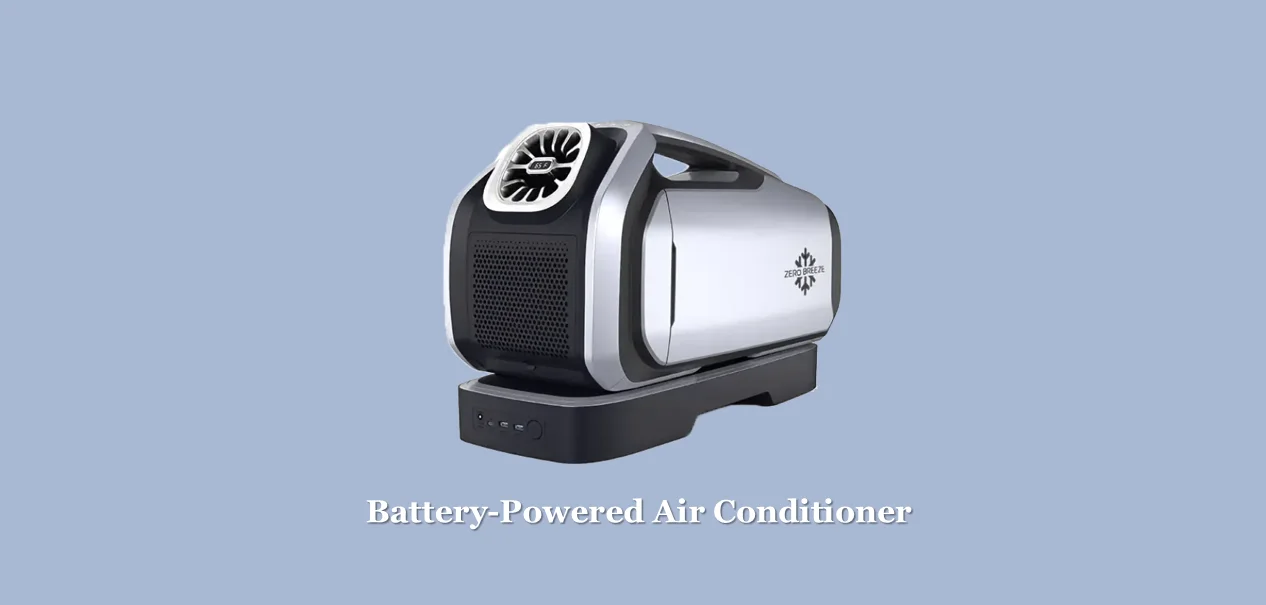
Battery-Powered Air Conditioners are AC that works on battery power. It is a great option for people who want to take their air conditioner with them on the go, or for those who want to be prepared in case of a power outage.
The battery-powered AC unit is also an excellent choice for people looking for an eco-friendly option. These types of air conditioners don’t use Freon, which can be harmful to the environment. Instead, they use a more environmentally friendly refrigerant.
The advancement in cooling technology enabled our HVAC engineers to create these kinds of air conditioning units. One such example of our battery-powered air conditioner is Zero Breeze Mark II.
The Zero Breeze Mark II is a battery-powered air conditioner that can cool a small space for up to five hours on a single charge. It uses 24V lithium-ion batteries that generate 2,300 BTU cooling power capable of generating 650W energy.
This portable AC unit is great for camping, tailgating, or any other time you need to keep cool without access to electricity. The Zero Breeze Mark II uses a safe, eco-friendly refrigerant called R134a. This type of refrigerant has been used in car air conditioners for years and is much safer for the environment.
Another great thing about this air conditioner is that it’s very quiet. You can easily use it in your bedroom at night without being disturbed by the noise.
The only downside to this air conditioner is that it’s not very powerful. It can only cool a small space, so it’s not ideal for large rooms or hot climates. But if you need a portable AC unit that doesn’t require electricity, the Zero Breeze Mark II is a great option.
One thing to remember with battery-powered AC units is that they require regular maintenance. The batteries need to be replaced every few years, and the entire unit must be serviced every five years.
Overall, battery-powered air conditioners are an excellent option for people who want to be prepared in case of a power outage or for those who are looking for an eco-friendly option. Just make sure you are aware of the regular maintenance required.
How to Choose the Best Type of Air Conditioner for Your Home?
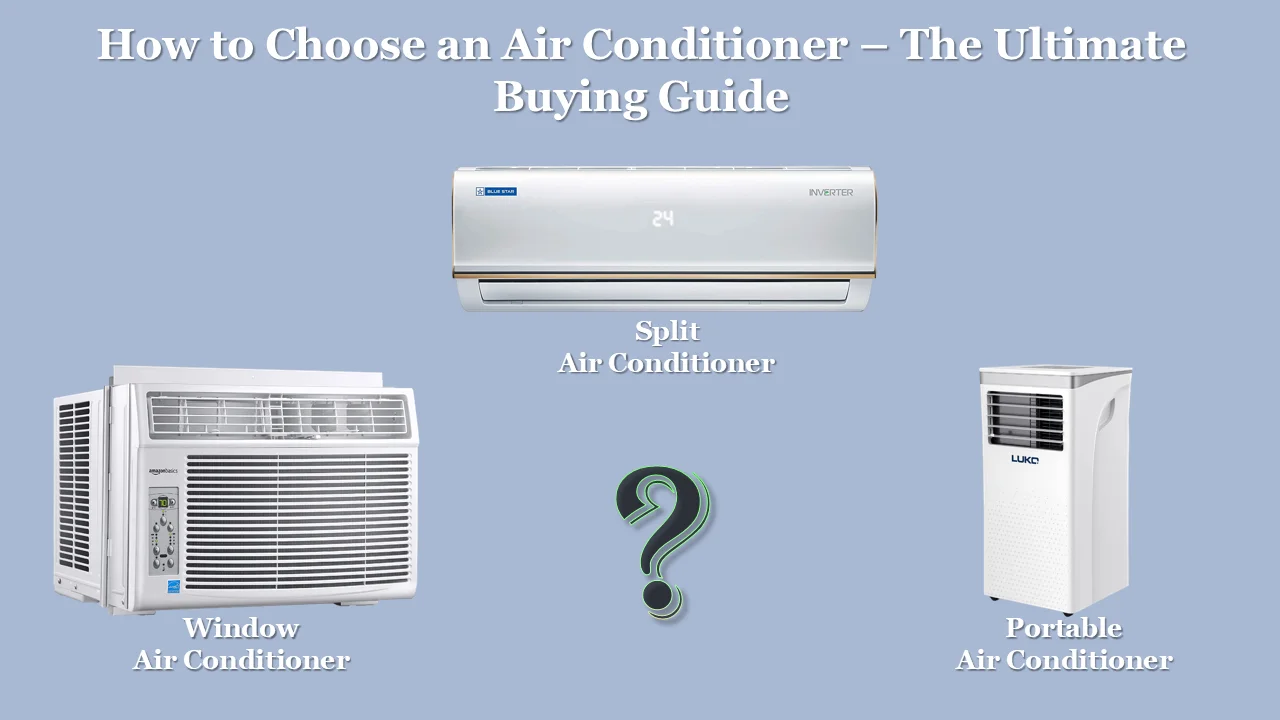
Now that you have seen almost all the different types of Air Conditioners available in the market, it’s the best time to decide on the most suited AC system for your home. Here are some essential factors you need to consider:
- The size of your home
- The climate in your area
- Frequency of Usage
- Your budget
Size of Your Home
If you live in a small apartment, a portable air conditioner might be your best option. These AC units are easy to move from room to room and don’t require any installation.
If you live in a mid-sized home and need only specific rooms, then a window AC or ductless mini-split might be the better choice. These AC units are more powerful than portable ones and can efficiently cool a mid-sized space.
However, if you need to cool the whole house, you can use a ducted mini-split AC or cassette AC.
If you live in a large home and to cool only specific rooms, then a PTAC unit or Multi Split System is best suited. However, if you need to cool the whole house, I recommend choosing a Central Air Conditioning system.
Climate
The climate in your area is also an essential factor to consider. If you live in a hot, humid climate, you’ll need an AC unit that can cool and dehumidify your home quickly and efficiently. In these conditions, refrigerant-based AC units such as Window AC, PTACs, Split ACs, etc., are recommended.
You can also choose a good dehumidifier unit if you live in a humid area. But an evaporative or swamp cooler might be better if you live in a dry climate.
If you live in a milder climate, you might not need as powerful of an AC unit. You can choose an Air Source Heat Pump unit.
Frequency of Usage
Another factor to consider is how often you’ll need to use your air conditioner. A portable AC unit might be the way to go if you only need it occasionally. But if you use it daily, a more powerful AC unit might be better.
Budget
Finally, you’ll want to think about your budget. Air conditioners can range in price from a few hundred to several thousand or more, so it’s crucial to find one that fits your budget. Choose the best AC unit you can afford while still getting the features and power you need.
Choose the type you need.
Overall I personally recommend you pick the type you need.
Also Read: How to Choose Air Conditioner- The Ultimate AC Buying Guide to the Perfect AC
Frequently Asked Questions
Final Verdict
There you have it! The 22 different types of AC units for home use. Now that you know about the different types of Air conditioners, you can decide which one is right for your needs.
If you need a small and affordable AC unit for a single room, a window air conditioner is a good option. If you want a portable AC unit that you can take with you wherever you go, a wearable AC is a good choice.
And if you’re looking for an energy-efficient AC unit that will save you money on your utility bills, a geothermal air conditioner is the way to go.
Hopefully, this guide has helped you decide which type of AC unit is best for your needs. If you need to buy a brand new air conditioner and don’t know about the different factors that play a major role, you can go through our comprehensive AC Buying Guide that will help you to choose the best AC for your requirement.
However, if you are confused about the required tonnage of needed for your space, you can check our online AC tonnage calculator tool. Stay cool!
Thanks for reading!

